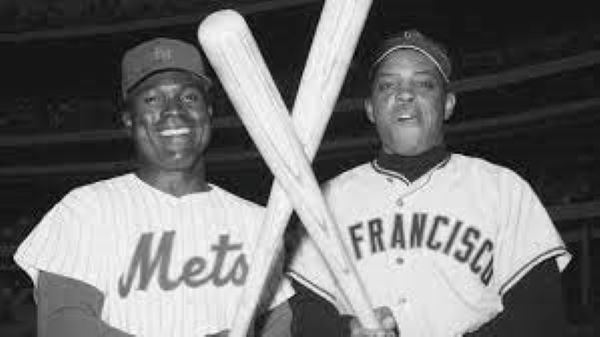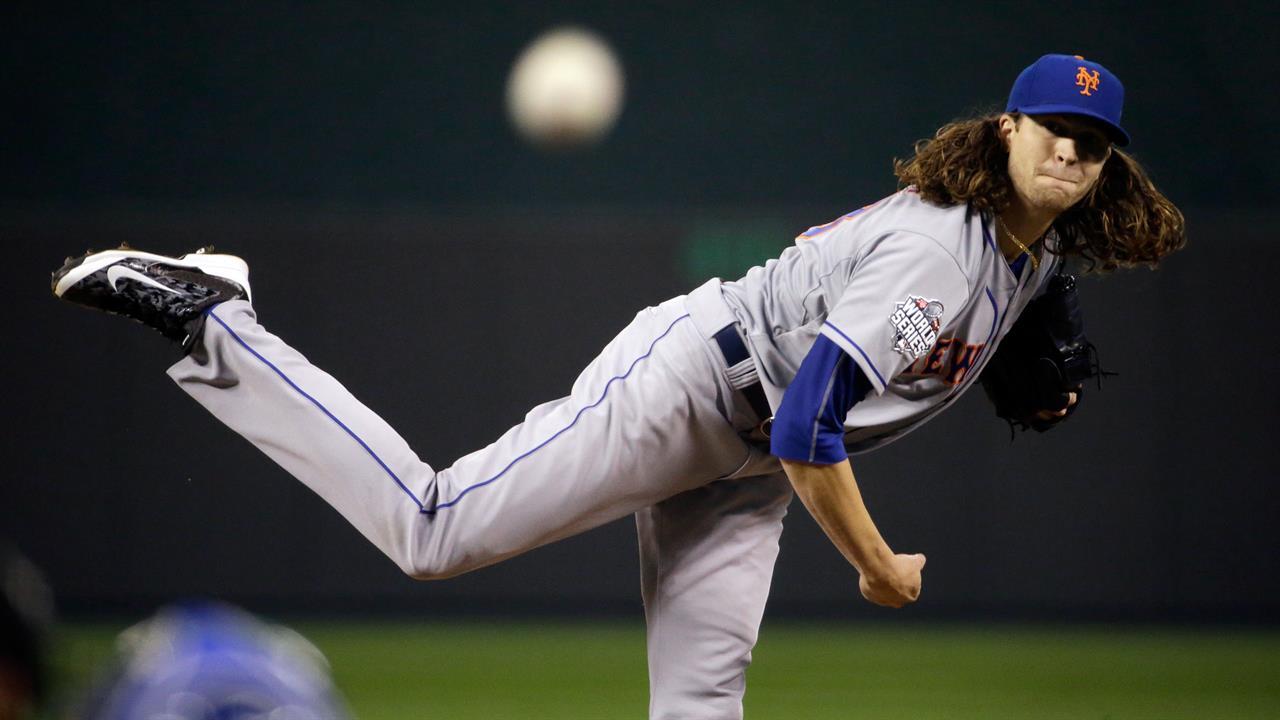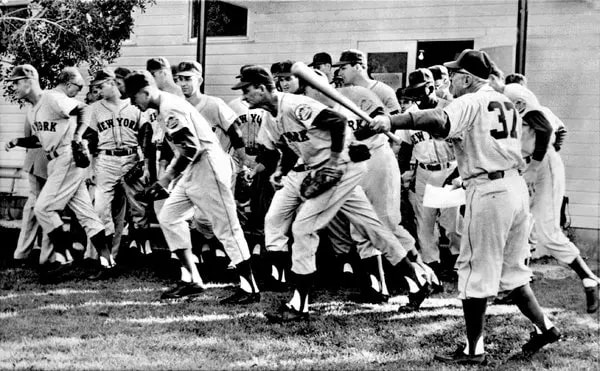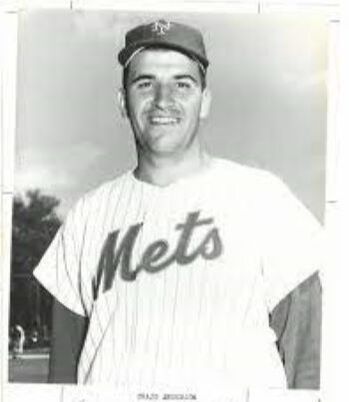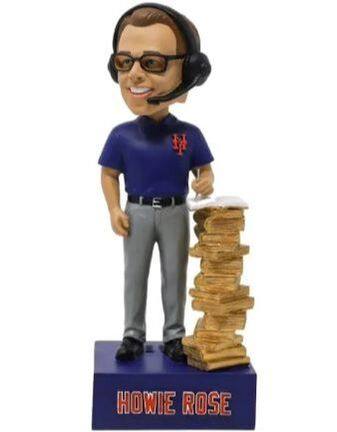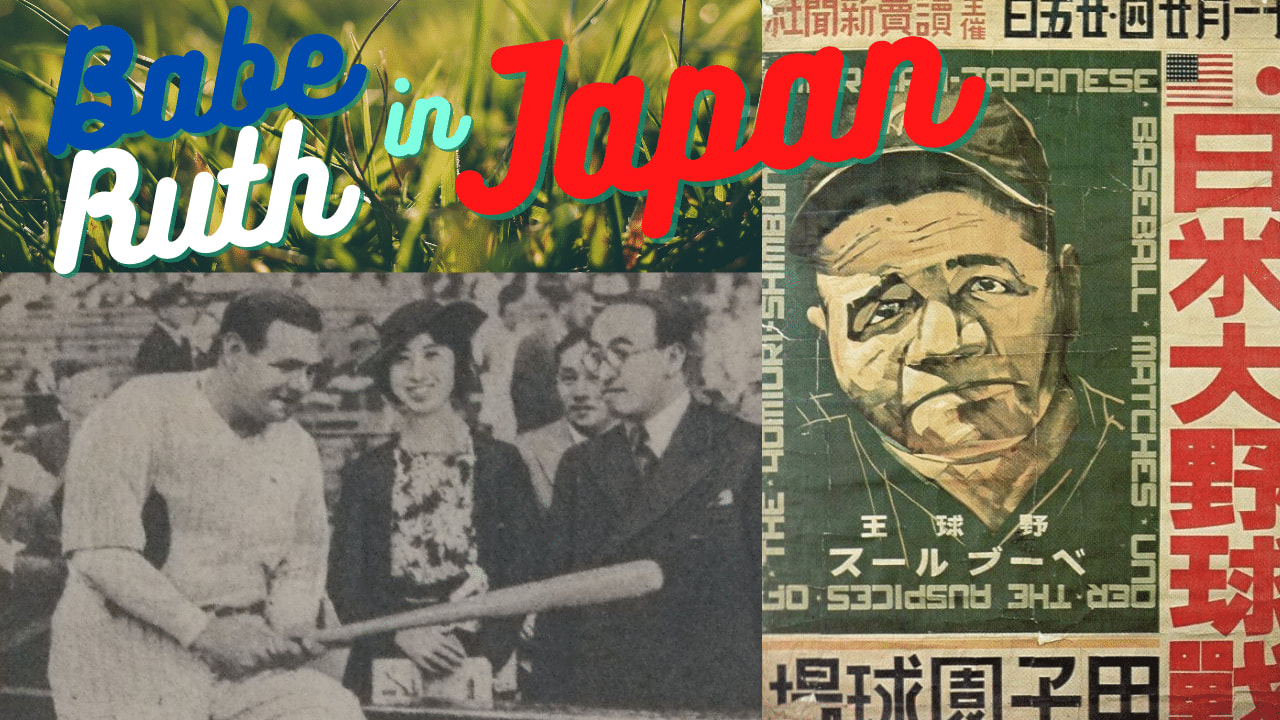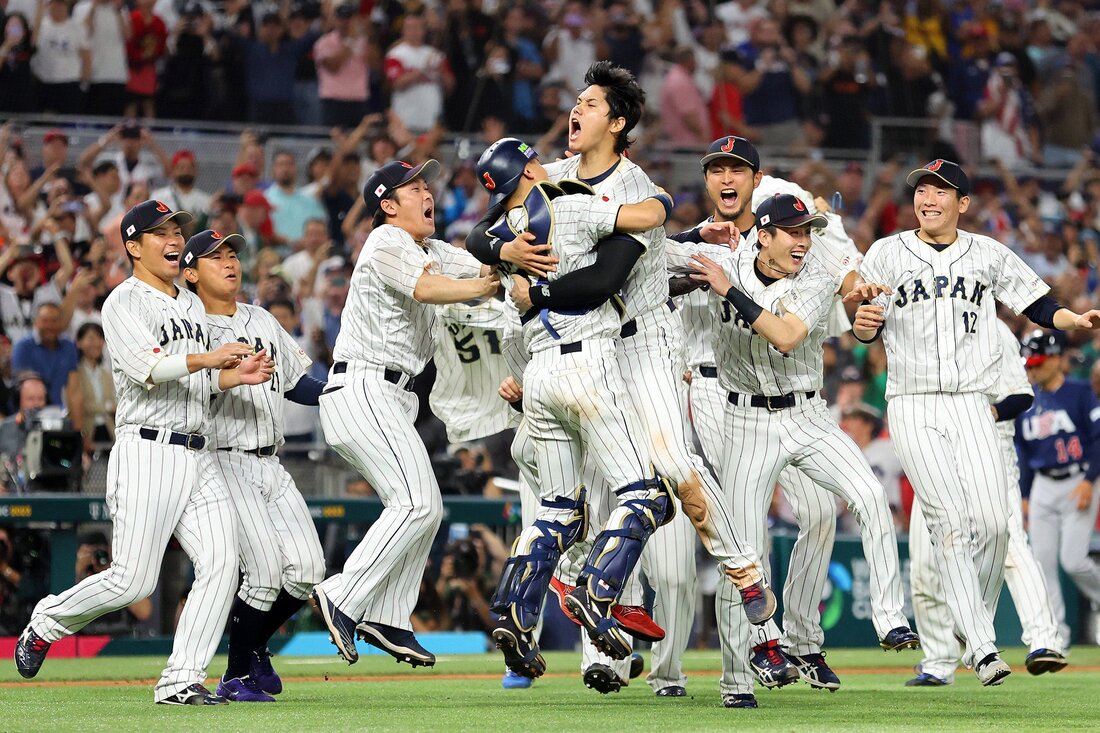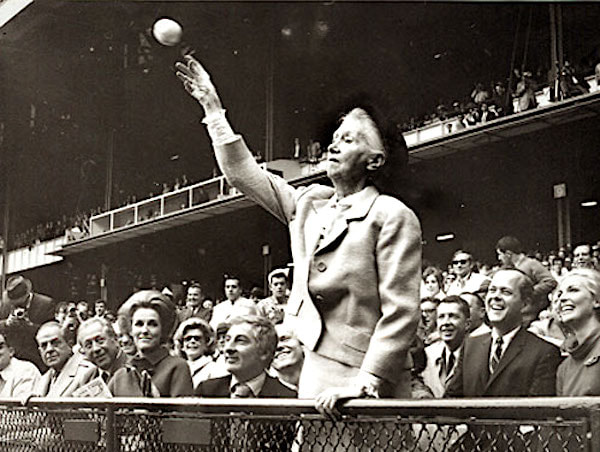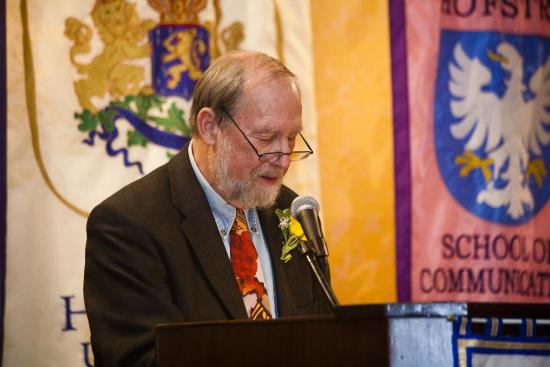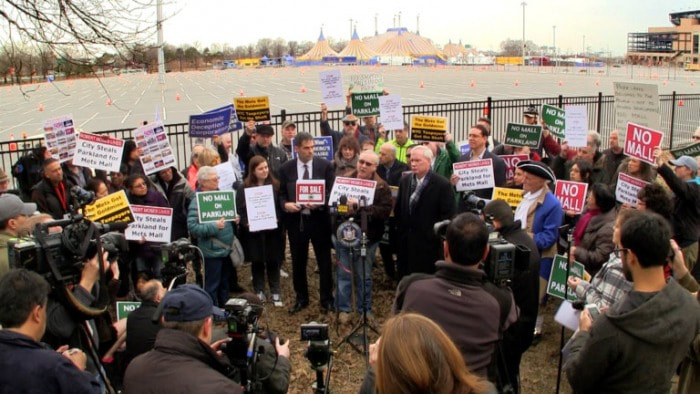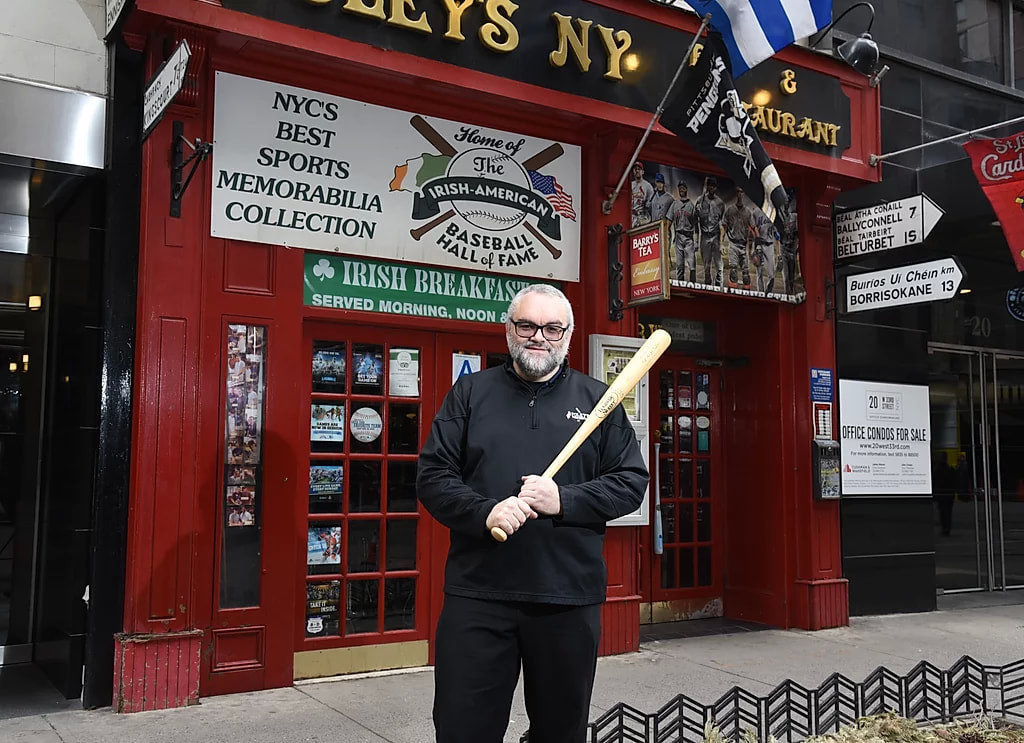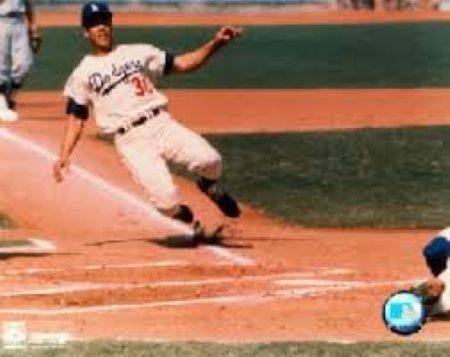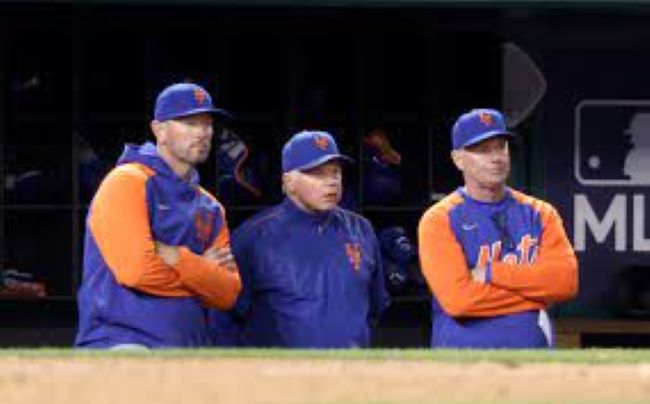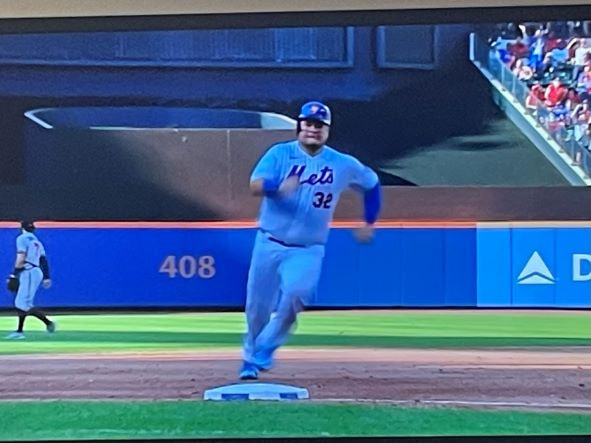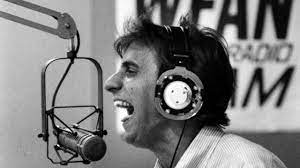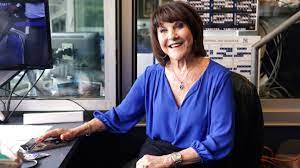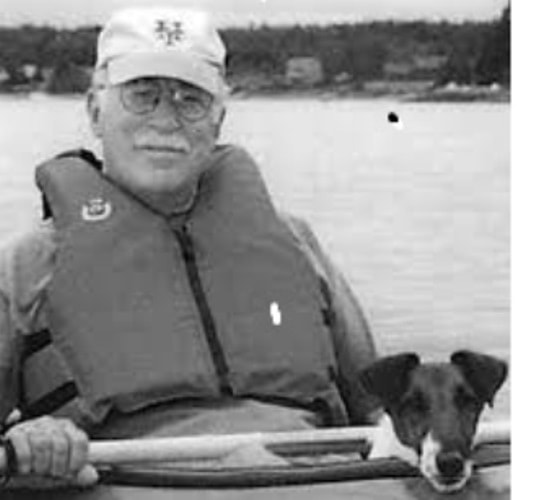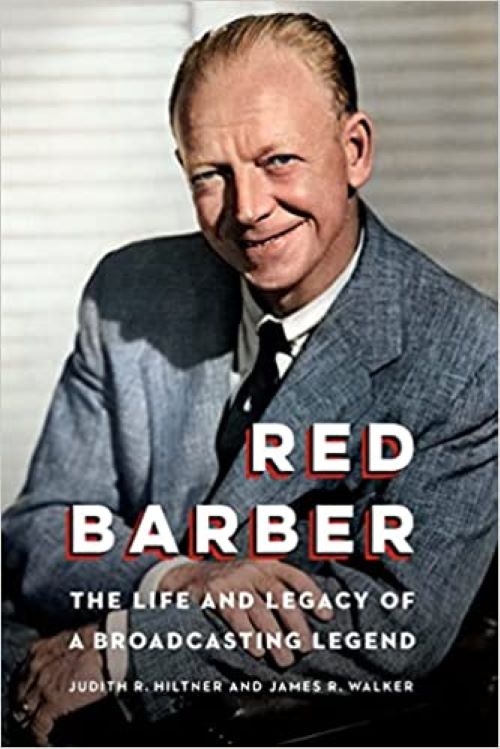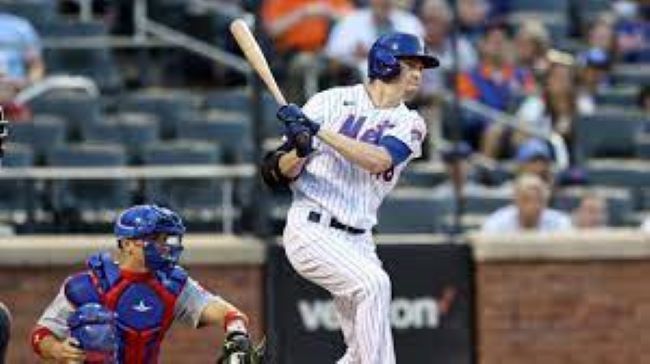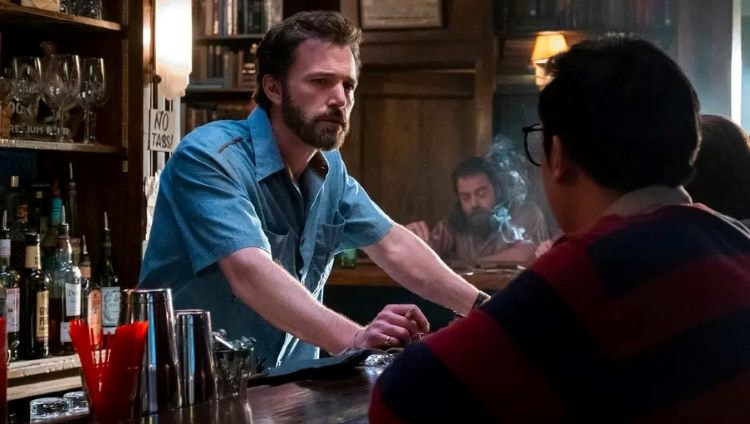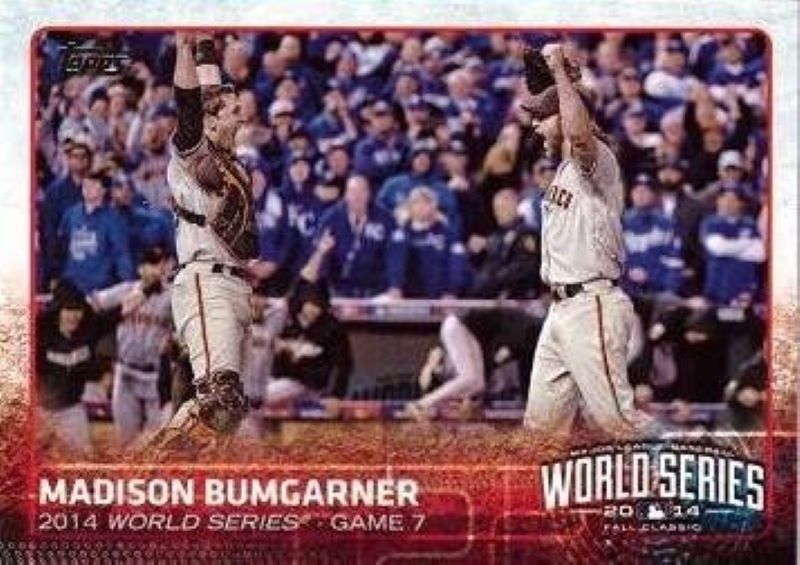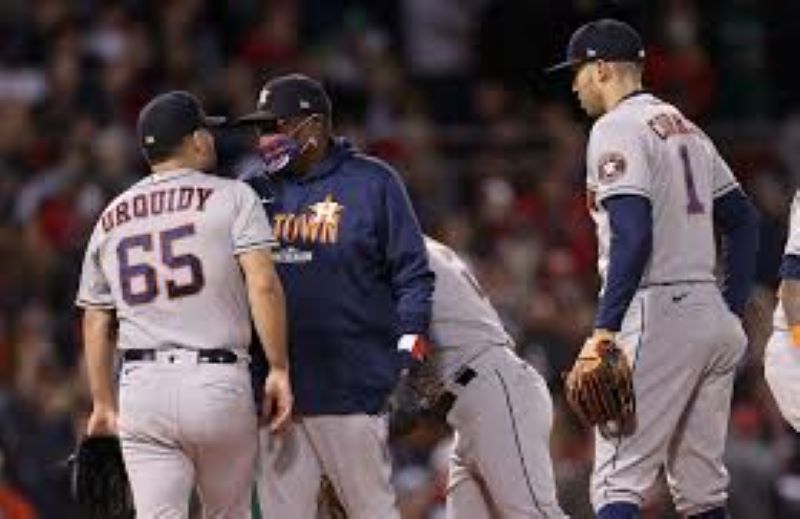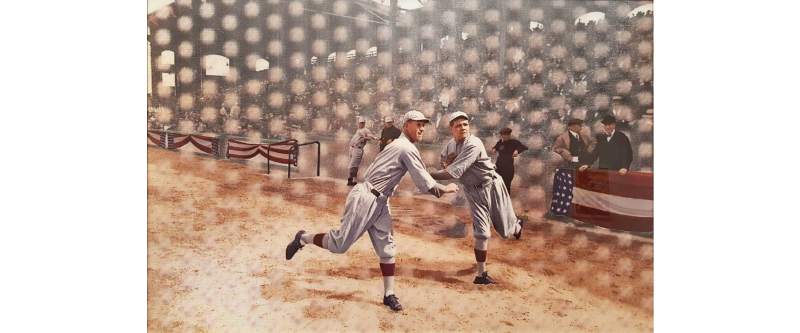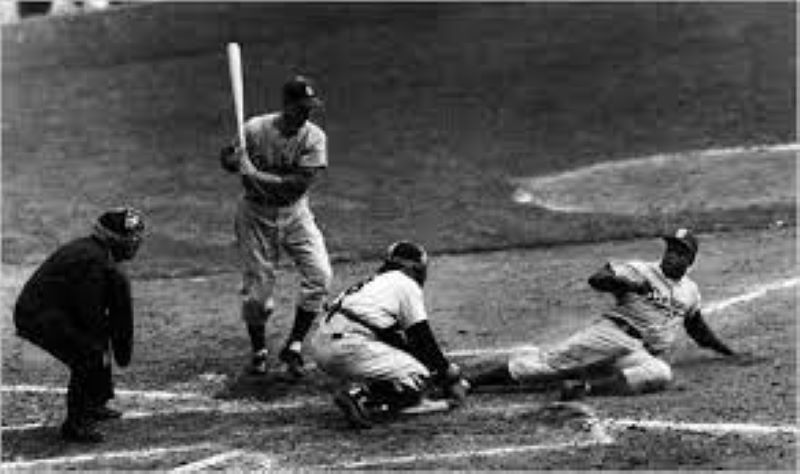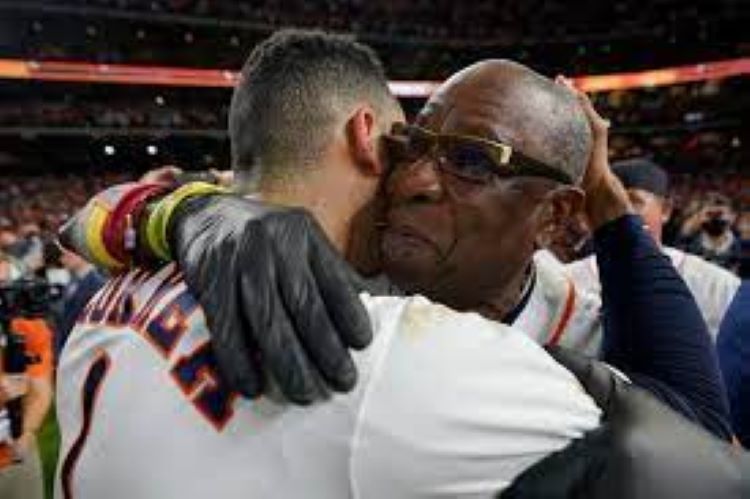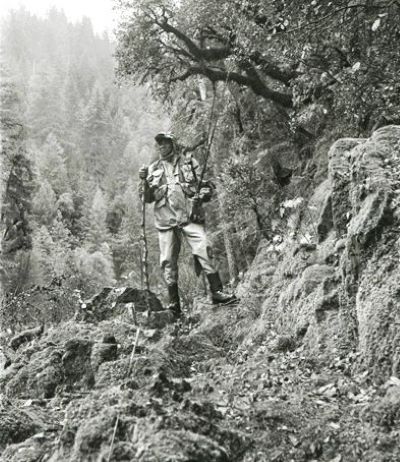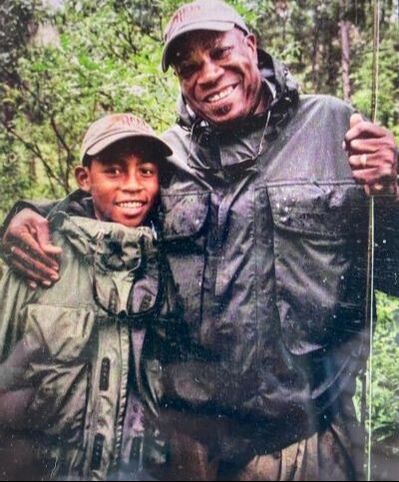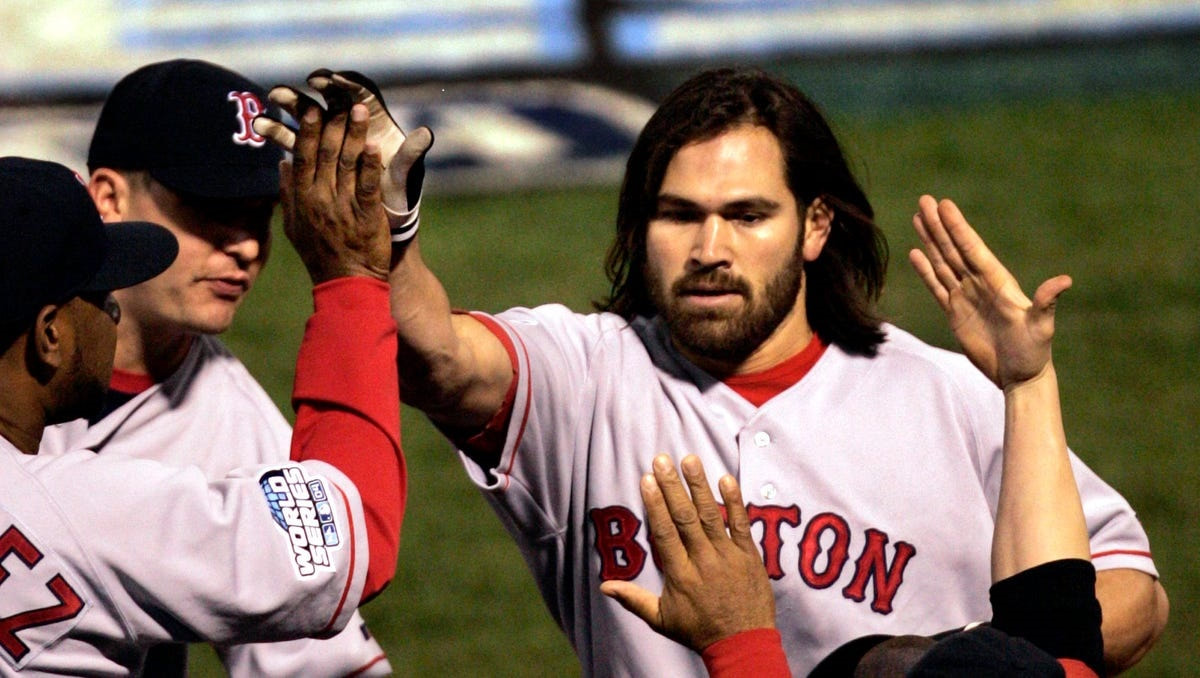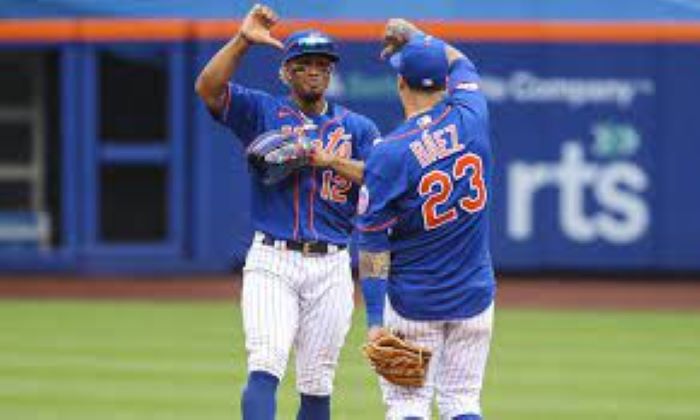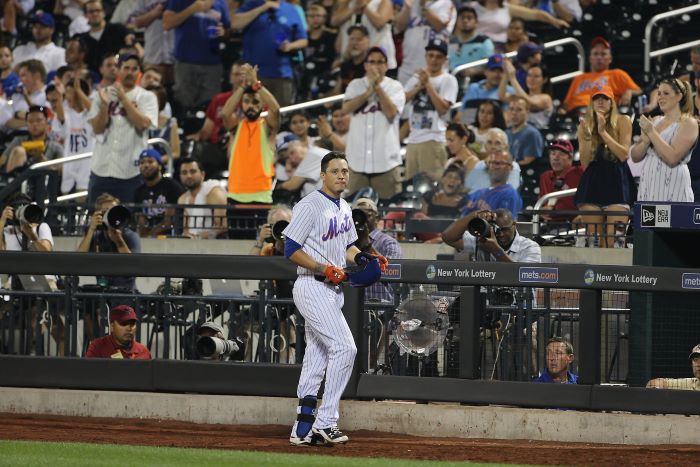|
I’m finishing up a four-day sabbatical from watching baseball – although not necessary from thinking about baseball, talking about baseball, writing about baseball. Fact is, two friends – former ball players, now faithful e-mail correspondents, have added to this missive – and a few family Mets fans pulled me back into the game when I was supposed to be resting my brain. I had made a conscious decision to avoid the All-Star Game on Tuesday, plus that gimmick called the Home Run Derby on Monday. Like many Mets fans, I had my fill of mood swings in the first half of the season – the Mets stunk, too many pitchers I never heard of, too many rumors that Pete Alonso would be scuttled. But then the Mets made a gallant run in the month or so before the All-Star Game, rushing into third place. I watched so much that I could justify ducking the all-star events. Plus, I cannot stand network baseball -- too much witless testosterone from old stars, too much born-yesterday overkill from the network booth. I wanted the terrific Mets commentators – Cohen, Darling, Hernandez, plus Good Old Howie Rose on the radio -- to rest their lungs, their eyes, their wits. And I would do the same. However, on Tuesday evening, I was listening to the dulcet tones and expertise of Terrance McKnight on WQXR-FM, when I heard my cellphone popping. It was a family member griping about the garish uniforms on the all-stars, a comment backed up by two family Mets fans upstate. I flicked on the tv, saw the ridiculous gear --convinced all over again that Commissioner Rob Manfred has no feel for the sport. Bad enough baseball is now in bed with gambling dens. Now it is hustling overkill uniforms. Back to classical music. However, two friends were still buzzing about the all-star uniforms. I heard from Bill Wakefield, who pitched for the Mets in 1964 and has saved up a lifetime of memories. (Pitching to Willie Mays! Running around New York with Hot Rod Kanehl! Studying Casey Stengel up close!) Now a retired businessman in the Bay Area, Wakefield proposed baseball switch to uniforms sported by barnstorming teams with Babe Ruth and Lou Gehrig. Good idea. Wakefield wrote about the first all-star game he remembered from his youth in Kansas City – a rain-shortened game in Philadelphia in 1952, won by diminutive lefty Bobby Shantz. Yes! I also heard it on the radio. Wakefield’s reverie triggered my memory of the first All-Star Game I attended – 1949, my father took me to Ebbets Field, great seats behind home plate. For whatever reason, one of my strongest memories is Andy Pafko of the Chicago Cubs, getting a hit, running the bases in the the Cubs’ traditional home uniform, with red logo. What a concept! I sent my Pafko memories to Wakefield, and also to my friend, Jerry Rosenthal, all-conference shortstop at Hofstra College in 1960, then two years as an infielder in the Milwaukee Braves farm system. Jerry – from Madison High in Brooklyn! – had the immense good fortune to study under farm-system coaches Andy Pafko (who had been traded to Brooklyn in 1951) and Dixie Walker (the Peepul’s Cherce in the mid 1940s.) Jerry, later a schoolteacher in Brooklyn, came through, as I knew he would, with his memories of Pafko and Walker. From Jerry Rosenthal:  I was thrilled by seeing that Andy Pafko baseball card! I will never forget Andy ; one of the finest men I ever met! During the Braves' minor-league spring training camp of 1962, in Waycross, Ga., I got up the courage to asked Andy about "the shot heard round the world"! It was in the "rec" room, after one of our afternoon games. Somehow, I was one of Andy's favorites. That was partly because I was from Brooklyn and we could talk knowledgeably about the old Dodgers and the wonderful Brooklyn culture of the early 1950's! By the way, Dodger fans loved Pafko! Andy told me that he actually cried when when the Dodgers traded him to the Braves! He also said that his time in Brooklyn were his happiest years in baseball!” (Jerry recalled how he asked about Pafko’s moment in 1951, watching Bobby Thomson’s home run sail over his head into the lower deck at the Polo Grounds.)
Jerry wrote: "I finally asked him about Bobby's historic "shot." "I distinctly remember Andy saying: "I played many years with the Cubs, so I knew that that any hard-hit ball in the air that was pulled by a right handed hitter was going out! He added that "he could, at times, tell by "the crack of the bat" when the ball was gone"! He said he “heard it clearly." "Maybe that was because of the sparse crowd at the PG on that momentous day! "That iconic picture of Pafko looking up at the lower- left field deck is branded in the collective memory bank of even the casual baseball fan! "Most fans still think Bobby's homer was hit into the upper deck, maybe that was because it looked like Andy was looking high up! Andy told me that he always got this question: "Did you think you had a chance to catch the ball?" It was impossible to jump anywhere near a wall that was fifteen feet high! "Durocher actually commented on the rarity of homers being hit into the lower left field deck; most homers were hit into the overhang of the upper deck! Bobby hit a sinking line drive off a fastball! it quickly disappeared into the lower deck! "As fate would have it, Bobby Thomson was traded to the Milwaukee Braves and roomed with Pafko for a few years! They became close friends. At first, Bobby wore his number 23, the same number as when he was with the Giants, until he switched to 25 the next year. "I wore that hand-me-down number 25 jersey at Eau Claire. Wish I had that jersey today with "Thomson" embroidered in red thread on the inside. By the way, picture available.) "Here's a fact that most baseball fans never mention: Andy Pafko took over the third base position from Stan Hack in 1945 and played third base in the Cubs - Tigers World Series. "The Associated Press named Pafko to the All Star game as the starting third baseman, even though the game was not played in 45' because of the War. "So Andy was one of the rare major leaguers who made the All Star team playing two positions ( all told- Pafko played in five All Star games - one at third base and four as an outfielder ). "Pafko ended his wonderful ML career by being replaced in right field by Hank Aaron! Not a bad way to go out!" *** (Jerry, who was in several English classes with me at Hofstra, finished with a flourish:) "George, couldn't agree more about those beer-league uniforms worn by All Star players! It irritated me so much I watched part of the Republican Convention! "I took an antacid tablet and went to bed! " *** GV: I have the feeling baseball is going to come in handy in the months to come.
16 Comments
Bill Wakefield pitched only one season in the major leagues – 1964 – but he finds himself tied to Willie Mays, who died the other day at 93.
We both got to see Willie Mays up close – me as a young sportswriter, realizing that Mays was uncomfortable with the new breed of mostly-New-York writers (The Chipmunks) who asked him layered questions. Willie was not the bubbly young star described by the writers who had covered him back in his Polo Grounds days, when he was a kid out of Alabama. Wakefield was a rook out of Stanford University in 1964. He saw Willie Mays at 60 feet, 6 inches – close enough to justify the Willie Mays baseball card he had treasured as a kid in Kansas City, Mo. I was not surprised this week when I received an email from Wakefield, talking about 1964. The two of us have Casey Stengel and Hot Rod Kanehl and Willie Mays in common, “Willie's passing is being covered with proper respect by the finest sports writers in the nation. I agree with all their tributes. I cannot add to their wonderful admiring thoughts,” wrote Wakefield, now retired in the Bay Area. “But…my modest contribution to my friends,” Wakefield continued. “Everyone has a personal take on what a hero's passing at 93 means to them. “1951 - Card below - Butch and I ( age 10) open baseball card bubble gum packages on our front porch in KC. "Hey here's a Willie Mays - " My observation - Willie is EXACTLY 10 years older than me. Willie 5/1931 Billy W. 5/1941. Thanks to my dear mom Bobbie -- didn't get thrown out and I've still got the card!!!!!!” (GV: Mothers get the rap for tossing out old cards and autographs, in the name of order.) Wakefield continued: “1961 - I'm playing first year with Cardinals -- Lancaster Red Roses -- I'm 20 and Willie is 30. I wonder - maybe at some point I'll face Willie.” Then it was 1964, and Wakefield was a rook with the hideous but amusing Mets, studying Casey up close. The man on the trading card materialized in Wakefield’s life on May 15, 1964, as the Mets flew west for a weekend series with the Giants. They actually had a 4-2 lead in the eighth inning when….but let the great and invaluable website, Retrosheet, tell the story: https://www.retrosheet.org/boxesetc/1964/B05150SFN1964.htm There is no suggestion that Willie nearly hit one out – just a fly ball to Jim Hickman. Wakefield got 6 outs against a terrific team. Wakefield started against the man on the playing card on May 31 in Shea Stadium. This time he gave up a run-scoring single to Mays in the first inning, and was removed after two innings. The game went on so long that Casey was ruminating about putting Larry Bearnarth in the game -- not a bad idea, except that the two college boys had already pitched in that game. Bearnarth and Wakefield did the most logical thing – dressing in civilian clothes and slipping into the stands and sipping a cold beer and witnessing manager Alvin Dark switching Mays to shortstop for the 10th, 11th and 12th inning. (Dark had used Mays for one inning the previous season: https://www.cbssports.com/mlb/news/photo-of-the-day-willie-mays-shortstop/ The second game in 1964 went 23 innings and, of course, the Giants won. Wakefield would see Mays again in August in Shea Stadium: “I throw Willie a good sinker ( I thought) down and in ( It WASN'T a low hard slider!!) -- he hits it out off the scoreboard in right center …inside-out swing . Loud LOUD!! crowd cheer -- Mets fans / Willie fans!!” No shame in being stung by Mays, who would finish with 660 home runs. Wakefield’s list of Mays sightings continued to 1973: “I play in an Old-Timers game at Shea -- vivid memory -- I'm the old timer and Willie is still active player (his last year) for the Mets. Pre-game Mets Clubhouse exchange - DiMaggio (The DiMaggio) is dressing next to me -- Willie comes over. Big smile.” "Hey Joe" - and I get a head nod!!” “Willie is 42 I'm 32.” “2024 -- I still have my Willie card. Willie passed away at 93. “RIP, Willie. A sad day. My hero.” Some of the greatest players ever – Ted Williams, for example – speculated that Mays was the best. This judgment certainly came out in the stirring obituary by Richard Goldstein for The New York Times:puhttps://www.nytimes.com/2024/06/18/sports/willie-mays-dead.html And there was a lovely column by Kurt Streeter, the last NYT sports columnist before that newspaper entered a compact with some sports website. I had no issue with Streeter describing Mays as stumbling with the Mets in the 1973 World Series. Bless his heart, Willie stayed active into athletic old age, and he lived to be 93 – and people remember him for “the catch” in the 1954 World Series. https://www.nytimes.com/2024/06/18/us/willie-mays-death-baseball-legacy.html Bill Wakefield can proudly display his Willie Mays card, and he can recall Willie’s three innings at shortstop in that monumental game in 1964. I did not remember Mays’ four career innings at shortstop but they must have invaded my brain, because I once wrote about picking an all-star team in the mythical Game to Save the World. As I recall, my choices for outfield were Ted Williams, Henry Aaron and Babe Ruth (with apologies to the likes of Roberto Clemente, Joe DiMaggio, Stan Musial and Mickey Mantle.) And what about Willie Mays? Just like Alvin Dark,I put Willie at shortstop, on the theory that Mays, whether at center field or shortstop, was the greatest baseball player ever. *** On the 50th anniversary of Willie Mays’ immortal catch, I wrote about how Arnold Hano wrote a slim masterpiece of a book about the game: https://www.nytimes.com/2004/09/29/sports/baseball/hazy-sunshine-vivid-memory.html?_r=0 ### It’s October and the Mets are in the post-season, so right away it is obvious that this new book is a heavy case of fiction.
The 6-foot-5 rookie pitcher and the young catcher are having an affair. Roomies. Love at first flashing of the signals. Hence the novel “Curveball,” by Eric Goodman, published this week by Post Hill Press of New York and Nashville. Goodman is such a Mets fan that he handles the sweet ironies of the Met condition – off the top of my head, including Casey and the bed-sheet banners. Marvelous Marv missing two bases, not one. Swoboda’s diving catch. Mookie’s dribbler. Santana’s no-hitter with an asterisk from an ump. DeGrom-the-Pheenom, vanished without a kind word. Nowadays the Mets have an owner who wants to build a gambling den next to the ballpark in Queens, and call it an oasis for the working class. And meantime the franchise falls apart. Oy. Then again, the Mets have always been a sweet-and-sour franchise. Now Eric Goodman, Yale ’75, has written a second novel about the improbable poignancy of the Mets, even using the real name of the franchise because, you know, you couldn’t make up this stuff. The Curveball in question is tossed by life – a 6-foot, 5-inch pitcher with a wingspan, whose father and grandfather nicknamed him Two-J’s, that is, Two Jews. Jesse Singer figured out long ago that he is gay, and he doesn’t try to have it both ways. He is gallant to the sweet young woman who offers to be his decoy; but he knows he is attracted to the young Mexican catcher, Ramirez, nicknamed “Rah,” who is going to make the team this spring of springs. Jewish Joe Singer has been in an Eric Goodman novel before – “Days of Awe,” which in 1992 prompted me to write a sports column in The New York Times. (Honest, a sports column in The Times, the olden days. You could look it up.) https://www.nytimes.com/1992/09/27/sports/sports-of-the-times-commish-a-literary-heavy.html Jewish Joe Singer got in trouble for not reporting a random suggestion (from his bookie father) to affect a game for gambling purposes. This was back when Baseball Commissioners like Bart Giamatti and Fay Vincent scorned gambling; Jewish Joe’s career veered into foul territory. “Curveball” contains three generations – Grandfather Jack has a lusty lady friend in South Florida. Father Joe is seeking modern treatment for prostate cancer that involves a new procedure in, of all places, Portugal. And Jess Singer is trying to make the varsity Mets squad, without calling attention to himself. The novel reflects how many players have been forced to keep their secrets. Glenn Burke played for the Dodgers and came out in 1982 when he retired, and he died young. Billy Bean, who played six years in the majors and came out when his career was over, and to baseball’s credit has beeb the official senior vice president of diversity, equity and inclusion. (Bean is currently fighting acute myeloid leukemia; his effective counterpart in the book is named Dean.) Goodman does a fine job depicting the conflicts of a young player – even as the Web leaks rumors about the rookie pitcher. Goodman’s other baseball novel – three decades ago! – brought Jewish Joe Singer to the “days of awe,” the very early fall, the time of Hank Greenberg and Sandy Koufax, who found their own ways to honor the Jewish holy days. The lore of real-life Jewish superstars. The Mets in this novel put a little extra pressure on the broad back of rookie Jess Singer – Number 32, once worn, and never to be worn again, by Sandy Koufax, once hailed in a winter baseball writers’ skit as “Sandy/you’re a Jewish Walter Johnson/you’re a dandy." In this knowing, compelling novel, Two-J’s path is his own. So many bad things going on, sport is the least of it.
But sport teaches you to hope, to endure – an experiment in a test tube. Take Edwin Diaz of the New York Mets. Last March his Puerto Rican national teammates piled on him in a victory scrum in the World Baseball Classic. The weight, the motion, crumpled his right knee. Within minutes, fans and players and doctors alike knew he would not pitch for a long time, or maybe ever. The gloom took over. If you ask me, the loss of Sugar Diaz caused the Mets to go into a shell, made stalwarts like Pete Alonso and Jeff McNeil try to over-hit the ball, put pressure on creaky elder pitchers – effectively ruining an entire season. Mets fans (and Mets writers) tend to think we are experiencing the mood swings of all humanity. We are from New York, representing New York, and we tend to think it is the center of the universe. So the loss of Edwin Diaz and his sizzling sideways slider put the entire planet off kilter (including things that really are important.) The season was empty. Darkness enveloped the land. The world was out of kilter, without the loudspeaker blasting the Edwin Diaz entrance anthem, “Narco,” recorded by an Australian known as Timmy Trumpet. Would we ever hear it again, see it again, cheer it again? Tonight (Monday, March 11, 2024) we heard it again, in an exhibition game in Florida. After a year of rehab and work, Diaz made his return in a spring exhibition game in the Mets’ home ball park in Florida. An electrical failure seemed a bad omen in the first inning, blacking out 10 minutes of tv, but the game returned, and in the fourth inning, the screen showed Diaz slipping into the bullpen, to warm up, as if he had never been away. In the top of the fifth inning, the sound system blasted the music of Timmy Trumpet, the ritual in our souls from the 2022 season. Edwin Diaz jogged to the mound and struck out three straight Miami hitters – all of them major-leaguers, not bushers filling out a road exhibition roster. His slider slashed at an impossible straight line from 90 degrees to 270 degrees, across the plate. Three straight strikeouts. Not even the emotional Mets fans could have hoped for this. Then Diaz skipped off to the home dugout to be embraced by staff and teammates. Back home in Long Island, all the bad stuff in the news – the fighting, the starvation, the threats, the bombast, the stupidity -- was temporarily overshadowed. Between innings, Diaz was interviewed Michelle Margaux, the sideline reporter, and I scribbled down phrases in quite decent English, like, “I feel good…amazing…in front of the crowd…I was making pitches….I want to say thank-you…I spent time with my family, my kids, I had time with my friends, and I was working hard…I missed my teammates…we are a family, really close….” Sugar Diaz said he had missed the trumpet at the ball park – but at home, he added, his two children often played “Narco,” the blare of Timmy Trumpet, which clearly revived the spring in the reconstructed knee of Edwin Diaz. So maybe this is the start of something – light instead of dark, warmth instead of wind, perhaps even, do I dare say it, sanity instead of madness. I am not sure I love the new ownership of the Mets – making Pete Alonso dangle, listening way too much to the analytics dweebs who value lusty longball swings rather than professional hitting strokes. In the Cohen stewardship, I have been brushing up on my Italian, the quote from Dante’s Inferno, that I memorized years ago: “Lasciate ogni speranza, voi ch’entrate.” (Abandon all hope, ye who enter.) In the daily grind of baseball, the buzz lasts only one night. But after watching the sliders of Sugar Diaz, I have hope, and that is something. I am so thrilled that the New York Times obituary editors ran a lovely obituary of Joe Christopher, a member of the early New York Mets – and my friend over the decades.
Joe touched a chord in me because he was mysterious and deep. I have learned more since he passed last week, from his daughter Kameahle Christopher. I also collected memories of Joe from two of his old teammates. In case you miss the NYT obit, here it is (for those who can access it). It is written by Richard Sandomir, now an obit writer, but previously a star sports-media critic (back when the NYT had a sports section.) https://www.nytimes.com/2023/10/05/sports/baseball/joe-christopher-dead.html I became intrigued by Joe Christopher in the first year of the Mets when he was a backup outfielder. Joe was from St. Croix, apparently the first player born in the Virgin Islands to play in the major leagues. He was a mix of cultures and languages, introverted, but also comfortable chatting with some of the young Chipmunk writers covering the club. “I’m a better ballplayer than you guys think I am,” he would say, softly. Sometimes he would chat with me about mysterious religious trends. I don’t claim I understood, but I think he sensed he had a friend. He was up and he was down with the Mets but in 1964 he played regularly and batted .300. (The obit tells how in the final game he dropped a bunt single in front of old Ken Boyer of the Cardinals to pretty much clinch the distinction of being a .300 hitter. In the pressbox in St. Louis, I almost cheered out loud.) His career sputtered again in 1965 and he was soon gone from the majors. Recently, two former teammates had nice things to say about Joe: Larry Elliott, a fellow outfielder in 1965, sent this memory: “I was trying to break up a double play against Philly. I did not get down in time and Ruben Amaro hit me in the back of my head with a throw. It was my fault. I was in the hospital for five days and Joe was the only one to come and visit me." My e-pal, Bill Wakefield, sent his memory of 1964, when he was a rookie out of Stanford and reported to the Mets’ spring hotel in St. Petersburg, Fla. “The front desk says, yes, we will give you a room, and assign your roommate. So I take my suitcase to the room. Open the door, and inside is a startled Joe Christopher. I said, ‘I’m Bill Wakefield and I’m your roommate.’ He seemed surprised but said, fine” (Wakefield doesn’t need to note that Blacks and whites were not rooming together in those days. And Christopher, who had been introduced to segregation in the U.S., was surely aware of that.) Shortly, Wakefield received a call from Lou Niss, chain-smoking, worry-wart travel secretary of the Mets “Come to come to the lobby immediately. I assume it's to get instructions -- don't drink in the hotel bar -- that's Casey's spot -- don't be late for the bus -- wear shower shoes on the bus not spikes, etc. “He says – ‘ Bill we are moving you in with Larry Elliott -- make the change immediately.’ And sort of as an afterthought, he said -- I paraphrase – ‘Baseball has made progress but we are not ready for black and white roommates yet." “I have no idea -- I just want to do all the right things. So I go back down to the room -- Joe is still there -- he kind of smiles at me -- and I said Lou Niss has assigned me a different room. “I always worried that Joe thought I had complained and that was the reason for the switch. I really didn't care. "So I packed up and moved to Larry's room.Joe never mentioned it again. He and I became pretty good friends. “Joe and I laughed about it over the course of the season. He even got a big smile on his face and would say ‘Nice going, Roomie!!!’ Great guy.” I have one more memory of Joe, who could wiggle his ears with the best of them. A knot of Mets writers were taking the sun behind the Mets’ dugout during a game in Chicago in May of 1964. As the Mets frolicked to an unforgettable 19-1 final score, Joe would trot in from right field after each inning, levitating his cap with his ears – just for the writers’ sake.” Joe’s major-league career fizzled but we kept running into each other. In the late 60s, I was in Puerto Rico writing for Sport Magazine about Frank Robinson managing a team in the winter league. I was at a game in Caguas when I spotted Joe playing for Santurce…and we agreed he would ride back in my rental. Then he won the game with a grand-slam homer in the ninth inning and the fans were so annoyed that they made motions to tip my car over. We laughed about it all the way back to Santurce. I always reminded him how he almost got me killed. Joe and I ran into each other in the 1980s near Times Square. He was carrying a large rectangular portfolio used by artists to protect their work. He came up to the Times for a while, but I never saw his work -- part of the mystery of Joe. The other day, I chatted with Kameahle Christopher, a paralegal with Amtrak, who lives outside Baltimore, and asked about her dad’s inner life. “He was interested in pre-Colombian art,” she said. “He was in touch with the ancients, the Olmecs and Mayans. He was into numerology…would ask your birthday, would predict things,” Kameahle said. “He was gifted spiritually.” I asked her about her dad’s childhood and she said he was raised in Oxford, a small settlement in St. Croix. “He grew up in a small house in the mountains,” she said. “He walked everywhere, and when he came home at night, he learned to follow the North Star. He said, “‘I’m not going to grow up like this.’ Nobody had ever left the islands. He endured hardships, but he used to tell himself, ‘I’m Joe from Oxford…and if I have to walk, I’ll walk.” In his later years, Joe wanted a job teaching baseball; “he carried his baseball gear in his car,” Kameahle said. Joe would coach somebody for the joy of it, remembering how much he had learned from coaches like Rogers Hornsby, Sheriff Robinson, Paul Waner – and his driven roommate with the Pirates, Roberto Clemente. After talking with Kameahle Christopher, I felt I knew her dad better – where his inner strength came from, standing in the clubhouse, a marginal Met, telling young writers from New York: “I’m a better ball player than you guys think I am." Kameahle’s loving portrayal made me miss him even more. ## They pitched for the Mets in different centuries – Jacob deGrom at the start of his career, Roger Craig near the end of his.
They both won over the fans – deGrom for his long-haired exuberance in his early years: Craig for his gnarly perseverance near the end. DeGrom was shut down this week, at 35, facing perhaps two years after Tommy John surgery; Craig died at 93. *** In deGrom’s final years with the Mets, I always felt I was watching his last game. The Mets never hit for him; that flaw was not of his making. He had so many injuries, yet he gritted himself through five, six, seven innings before trudging off the mound, leaving behind a streak of strikeouts but not so many victories (82-57 record in nine truncated seasons with the Mets.) In a time of gigantic bullpen staffs and strangely influential analytic types, deGrom seemed temporary, vulnerable, doomed in a professional sense, despite the pitches that curved and slid and sizzled. It was pure baseball joy to watch him – fielding like the shortstop he once had been in college, swinging the bat like the daily hitter he could have been (and who is to say, maybe still could be?) He was a complete ball player, except for the flaws. Then he was gone, like a main figure in one of baseball’s strange layer of supernaturalism in “The Natural” or “Damn Yankees,” or “Field of Dreams.” Flash. Bang. Gone. Why did Jake go? Without getting into the dollars, it seems to me that the Cohen Mets made a respectful, calculated offer, based on the belief that deGrom’s apparatus would fall apart one day soon. The Mets front office seemed to be waiting for a sucker franchise whose officials did not read the papers or listen to talk radio or consult the available analytics. I have a parallel theory: As the Mets fell apart at home in the post-season last year, fans booed Chris Bassitt as he trudged off the field. “Shame!” I yelled at the TV. Fans in grand old franchises like St. Louis, Cincinnati, Pittsburgh, would not boo, even as a season was going down the drain. At the time, I wondered what Jacob deGrom, from central Florida, felt about that display of venom from Big Town? Was my question answered when deGrom took all that money from Texas and departed without one overt farewell or explanation or thank-you to Mets fans, at least one that crossed my consciousness? Whaever. I hope Jacob deGrom comes back -- in some vestige of that floppy youthful mop of hair and that nasty arsenal of pitches. Life owes him a few breaks. *** Roger Craig had a different kind of career. He turned up with the 1955 Brooklyn Dodgers, tall and slender, ahead of that lefty from Brooklyn, Sandy Koufax. He helped win the World Series – in 1955, “This Is Next Year” -- and then he went west with the Dodgers and helped win the 1959 World Series. In 1962, Craig was part of the expansion team in New York that had to fill the awful Dark Ages void left by the Dodgers and Giants. Craig’s mellow North Carolina accent and kind disposition helped influence a clubhouse after too many losses. In 1963, on a losing streak of 18 games, Craig switched from his No. 38 to No. 13 and was the winner when Jim Hickman hit a grand-slam home run against the looming left-field stands. In those two epic formative years in the Polo Grounds, Craig left his mark on the club – as did Richie Ashburn formerly of the Phillies and Gil Hodges formerly of the Dodgers. Never underestimate experience and leadership. Let me say this about the Dodger presence, commemorated in Roger Kahn’s classic book, “The Boys of Summer,” about the Bums of Ebbets Field. That team had many strong personalities and mature leaders, including Pee Wee Reese from border-state Kentucky, who set a tone in the clubhouse. In the last months of Ebbets Field, Cap’n Pee Wee noticed a young outfielder, Gino Cimoli, showered and dressed and heading for the door, in the still-promising late afternoon. “Gino,” Reese drawled. “If you’re in a hurry to get out of the clubhouse, you’re in a hurry to get out of baseball.” Cimoli sat down, maybe had a beer, maybe chatted with Dodgers around him. The Brooklyn Dodgers were a true team. Roger Craig came along in that milieu, and he passed it along to a motley squad of “Amazing Mets.” He pitched and he often lost and talked baseball and looked the writers in the eye and answered questions. In 1964 Craig was liberated, helping the Cardinals win a World Series. Later, as a coach, he taught a generation of pitchers to throw a split-finger fastball. Later, Craig managed the San Francisco Giants to a championship -- courtly, wise, always remembering familiar faces from those epic 1962-63 season in the rusty old Polo Grounds. When Roger Craig passed, Ross Newhan, long-time baseball writer for the Los Angeles Times, wrote this on Facebook: “Roger Craig, the original Humm Baby, died Sunday at 93, and I couldn't be sadder. There was no manager's office I more enjoyed walking into, no spinner of stories I more enjoyed inscribing. He won two World Series as a pitcher with the Brooklyn Dodgers, moved to L.A, and eventually became manager of the dreaded Giants, who never seemed quite as dreaded with Humm at the Helm. He was quite the guy, and I know my sadness is shared by Corona's Marshall family, Michelle being his granddaughter and Riley his great granddaughter, both frequent visitors to his San Diego Counthome. RIP Roger, you were one of a kind.” I think I can speak for the writers from those years: Ross Newhan got it right about Roger Craig. ### As of this moment, the worst seasonal record in the history of the major leagues still belongs to the 1962 Mets – 40 victories, 120 losses, for a nice round percentage of .250.
However, it looks as if the Oakland A’s – 11-45- .196 as of Tuesday morning -- might break that record. A lot of people who love the Mets are rooting for Oakland to somehow avoid a new low, and leave that honor to Casey Stengel’s 1962 Amazin’ Mets. Is that twisted? Not from my point of view. The 1962 season remains memorable – the first season for an expansion franchise created to replace the Brooklyn Dodgers and the New York Giants, who had bolted to California in 1958. The Mets were often terrible, but they were also a lot of fun, with Stengel diverting attention from all those losses. Now, 61 years later, many Mets’ fans – and also some vintage Mets players -- are saying they could easily live with that distinction. “Keep the record!!!” texted Bill Wakefield, who had a decent year as a reliever in 1964. “I want that to be forever,” says Howie Rose, the Queens kid living out the dream by broadcasting Mets games on the radio. He will be honored by the Mets Wednesday evening and will throw out the first pitch – as fans display their Howie Rose bobblehead dolls. Rose goes back to 1962 when he was 8 years old and his father took him to the Polo Grounds to see the new team. “Being a narcissistic kid, I thought it was all for me,” Rose told me over the phone on Monday. The Mets beat the Cardinals and Gil Hodges hit what turned out to be his last home run. Rod Kanehl – the scrappy minor-leaguer who came to be a folk hero of the early Mets – hit the first grand-slam homer in Met history! Complete game by Roger Craig! Felix Mantilla 4-for-4! My man Joe Christopher playing center field! “It was a year-long celebration,” Rose said, noting that the Mets somehow won a World Series only seven years later. Amazing. “You had to be there,” Rose said. Craig Anderson was there at the start – a Lehigh College graduate, obtained from the Cardinal organization, one of the many “university men” that Casey and Edna Stengel relished. Anderson was the winning pitcher in both ends of a doubleheader against the Milwaukee Braves, raising the Mets’ record to 12-19. Maybe they were not so terrible, some people said. They promptly lost 17 straight, and finished the season at .250. Anderson was up and down with the Mets the next two years, and ended his major-league career with 19 consecutive losses – which was the record going into the 1992 season when another Met, Anthony Young, kept losing. “When Anthony Young approached my 19 straight losses,” Anderson texted Monday, “I wrote him and said I hoped he did not break my record, to no avail. He had good stuff and bad luck. I did the best I could but lost some starts when relievers failed me. So that’s baseball…” Anthony wound up losing 27 straight decisions with the Mets and Cubs, and died in 2017. Craig Anderson, 84, watches the Oakland Athletics stumble, as the A’s ownership allows the franchise to dwindle, to make it easier to get out of town, to Las Vegas. (And why not, given MLB’s dangerous new flirtation with sports gambling?) Some people would welcome another team breaking the Mets’ 1962 record. Keith Hernandez, who helped win World Series for St. Louis and the Mets, said on a TV broadcast last week that the Mets and their fans should be glad to get rid of the streak. But Craig Anderson is not so sure. He took heart from the old-timers’ day in Queens last summer, a lavish reunion including a few original Mets. Anderson added: “Don't forget a truly professional man, Gil Hodges, on and off the field!” “After the recognition that my teammates and I received last August, I truly feel about playing on the first Mets team was a special moment in my career,” Anderson continued, saying his team was “a small part of baseball history and Mets fans made us feel special too. “So let our record stand. Mets fans proved to me that former players, win or lose, are still special” -- Craig Anderson, 1962 Original Met, and Proud of It.” ### Let me start by saying Babe Ruth is my favorite athlete, all-time.
Not just because I witnessed him, last game of 1947, clearly sick, addressing a crowd in Yankee Stadium. Not just because he had coached for my Brooklyn Dodgers for a while. Not just because I later met his daughter who talked about “Daddy.” I consider him my favorite athlete because he could pitch and he could hit and he could entertain fans just by being “The Babe.” Now I can say, I have also seen Shohei Ohtani pitch and hit in the same game, for the World Baseball Classic, holding off the Americans with skill and power and flair, just like the Babe. Whatever else is wrong with the world at the moment – don’t get me started – there is this versatile champion from Japan, thrilling fans around the world. By now, you undoubtedly know that Ohtani saved Japan’s victory over the United States late Tuesday evening (Eastern time), closing the game by striking out his Los Angeles Angels teammate, Mike Trout, with a hellacious slider that broke clear across the plate. If there is anything you don’t already know about Tuesday’s championship, try to log on to Tyler Kepner’s column in the Times, written right after the game. https://www.nytimes.com/2023/03/22/sports/baseball/shohei-ohtani-world-baseball-classic.html Tyler touched all the bases, with gusto and knowledge, writing: “ The tournament, it is safe to say, is no longer taking off. It is already in orbit.” The Babe, it is said, saved baseball by hitting more home runs than anybody had ever done, 29, while still a starting pitcher for the Boston Red Sox in 1919. In the same year, some members of the Chicago White Sox conspired to lose the so-called World Series, in a gambling plot, followed by sleazy legal maneuvers by the hangin’ jury of the baseball leadership. The Yankees purchased Ruth, who promptly hit 54 home runs and entertained the world (including Japan, on a barnstorming visit) for a decade and a half. Now, Shohei Ohtani has pushed the baseball tournament toward the grand tournament for the world’s most popular sport, soccer/football, the World Cup. In its own quadrennial tournament last fall, Argentina’s elder superstar Lionel Messi held off France’s young superstar Kylian Mbappé in an exciting final. Baseball still has a long way to go, around the world, but at least Ohtani has nudged his sport into the discussion of world events. Ohtani made baseball a 24-hour spectacle. I confess, as a notorious early bird, that I have rarely caught a glimpse of Ohtani (or, for that matter, Mike Trout.) I’m a Mets guy, a National League guy. But now Ohtani, with one inning of smoke, has inserted himself into worldwide consciousness. I woke up Wednesday morning and found an email from our friend Fumio, who used to live across the street on Long Island – such nice people, I think of him and Akie every day. back home in Japan. I replied to Fumio that as a baseball fan and a journalist, I recognized that the “story” was this poised young superstar holding off his Angels teammate and the American all-stars. It is now 105 years since Babe Ruth pitched and hit the Red Sox to a “world” championship. Imagine. One hundred and five years. An accomplishment I can legitimately label “Ruthian.” A week ago, I wrote about a terrific new biography of Jim Thorpe, by David Maraniss. I was particularly tantalized to read that the great American athlete, while at the Carlisle Indian School in Pennsylvania, had been friendly with a young teacher named Marianne Moore. Yes, exactly, the same Marianne Moore who soon moved to Brooklyn and became a famous American poet into very old age. Finding Miss Moore in a Thorpe biography touched off my recollection that in 1968 the worldly president of the New York Yankees, Michael Burke (whom I miss to this day), invited her to throw out the first ball on opening day. The mention of Marianne Moore also touched the heart of the writer, Sam Toperoff, who has been my friend and inspiration since he was a basketball player/scholar at Hofstra College in the late 1950s. Within 24 hours, I received Sam's email from the Hautes-Alpes department of France, containing references to two poets who won Pulitzer Prizes, 49 years apart – Marianne Moore (1952) and our friend Stephen Dunn (2001.) Sam wrote: “Dear George—After my first book came out, I got a call from the editor to tell me Marianne Moore loved it and wanted to talk with me about it. She invited Faith and me to tea on a sunny Sunday. She lived in a brownstone downtown, very near the Tombs. The fall of 1965, I think. She was, when she opened the door, indeed Marianne Moore, the old lady whose poetry I had studied as a student and taught as a professor at Hofstra. “Yes, I was intimidated. But the editor had told me she wanted to meet me because she thought me very brave to have endured all I had written about in my book when in fact for me it was just a normal accounting of my lower middle-class family life as I had lived it up to that point.” (NB: Sam’s first book was “All the Advantages,” circa 1965, which was nominated for a Pulitzer Prize by the Atlantic Monthly Press.) Sam recalled how Miss Moore “served tea and cookies she had baked herself. Marianne Moore! All was sort of stiff and formal until somehow the subject of baseball came up — I knew from her poetry she loved the game. Then she went off on the Dodgers. Remember, she had spent most of her writing life in Brooklyn; she had just moved to Manhattan. Well! She loved Pee Wee Reese, spoke poetically about him, how he glided, how effortlessly he played, how good he was for Jackie. Marianne Moore! She also lauded Red Barber for making her life so rich in her Brooklyn apartment. That was mostly what we talked about with Miss Moore that long afternoon — the Brooklyn Dodgers! “I signed my book for her; she signed her last collection for me. And we went home. Her volume sits on my shelf next to Stephen Dunn.” Before Stephen Dunn became a poet, he was a zone-busting jump-shooter teammate of Sam, who, on long bus rides into the wilds of Pennsylvania, encouraged Stephen to use the rest of his brain. My college athlete pals (I was the student publicist) followed Stephen’s fame and also his terrible battle with parkinson’s disease, which rendered him unable to recite his own work in later years, although he wrote to the end. Sam wrote: “As Steve was dying — I only thought he was ailing, damn it — he sent me a poem called ‘Final Bow.’ That’s when I got the message. Then when his collection came out, this was the poem he used to say goodbye, so he had orchestrated his own exit, the son-of-a-bitch. It’s a superb and funny and serious poem. “Hell, why don’t I type it, forgive me if I cry:” Final Bow In my sleep last night When the small world of everyone Who’s mattered in my life Showed up to help me die, I mustered the strength To rise and bow to them A conductor’s bow, that deep Bending at the waist, right arm across my stomach, the left behind my back. At first it seemed like the comedy of aging had revised and old scene-- how, with time running out, I’d make the winning shot In my schoolyard of dreams, Only now I was wearing an unheroic gown, apparently willing to look foolish-- for what? What no longer mattered?-- before I lay again down. ---Stephen Dunn, 2021 Sam wrote: “I take that last poem of his as something of a challenge: How to go out the right way.” Stephen died on his 82nd birthday in 2021. Sam added: “And yes, I did cry. I love this poem. I love him, his talent, his courage, his exit.” Larry Merchant writes, in the good old New York Post, about Marianne Moore:
https://storyoftheweek.loa.org/2019/10/poetry-in-motion.html It's bad enough that Baseball Commissioner Rob (Roll ‘Em) Manfred has brought about a sleazy era of gambling on the sport that has banned Pete Rose for life.
Baseball is also the former holier-than-thou business that banned Willie Mays and Mickey Mantle for fronting for gambling dens after their retirement. They were reinstated, but then Rose got busted for life for violating gambling rules. Nowadays baseball runs blatantly insulting commercials of young males displaying their insecurities by betting on sports events. Some hitter in a distant ballpark smacks a double off the wall and the young man leaps from his chair, as if he himself hit the damn ball. Encouraging gambling is Rob Manfred’s game, and maybe Steven A. Cohen’s world, on deck. The Mets’ owner is pushing to see if he can get away with building a gambling den a dice throw away the ball park named after a bank. Cohen has been an activist owner since taking over the Mets – getting rid of a lot of deadwood in the organization and spending millions upon millions for better players plus activists like Billy Eppler and Buck Showalter. Those are the current conditions, and Cohen spends and spends. (He also showed great showman instincts by staging two of the best feelgood events I’ve ever seen in a ballpark – the retirement of the No. 17 of Keith Hernandez, and reviving the Old Timers’ Game and festivities, including a dying John Stearns, and survivors of Mets’ stalwarts Tommie Agee, Alvin Jackson and Bill Robinson. Events like these do not just happen. They take money, and staff, and good instincts on the part of the still-new owner. One suspects Cohen will even go ahead and sign Carlos Correa, unless Correa truly has a lead leg. Cohen is no fool. He avoided getting stung by over-paying for the five-innings-a-week pitcher, Jacob deGrom, despite the grand memories of when deGrom was healthy. (As for deGrom’s cold-blooded “I’m rich! I’m rich!” smile when he bolted from the Mets with nary a kind word about the good times in Flushing: As we say in Queens, Yeccch!) Cohen understands the process of making more and more money. He has noticed the bleak concrete emptiness of parking lots -- “50 acres of asphalt" -- to the west of New Shea Stadium, and he has envisioned late-model cars bringing lucky tigers escorting handsome women, with money to burn. Or at least, that is the image. Fortunately, the governments of New York city and state still have a chance to veto a gambling den on very public land. (Wait, don’t Mets fans park their cars there 81 home games a year? Isn’t traffic bad enough in that tangled sector?) According to the Wall Street Journal, Cohen held an open house for interested Queens types the other day. No fool, Steven A. Cohen. He played down the lust for a gambling den by saying he just wanted to hear the opinion of the Queens folks – known for their cagey urban instincts (sussing out the criminality and bullying of former Queens resident Donald Trump.) At the open house, my Queens homeys seemed to voice a skeptical attitude toward the gambling den. According to the WSJ, the folks who showed up – for a ballpark frank! – voiced preference for live music, dining, art exhibits and festivals rather than gambling. The WSJ reported that Laura Shepard, a community organizer for the transit advocacy group Transportation Alternatives, told Cohen that the development should be a destination that people can walk, bike or take transit to — not just drive. “Personally, I don’t want to see the casino,” she said. “Most people want more green space, concerts and community events.” There is a lot of communal pride in Flushing-Corona-Jackson Heights-Forest Hills swath of Queens, home to a hundred languages and food tastes. This is the same region that fought back an attempt to build a soccer stadium on the crowded public fields of Flushing Meadows park a couple of decades ago. A big-time soccer stadium will soon be built where the chop shops once hunkered. Isn’t that enough upgrade for anybody? The locals should tell Cohen and Manfred: Go gamble somewhere else. Go to Atlantic City, that once bled the great businessman Donald J. Trump. Go to hilly Connecticut where white marauders once slaughtered Indigenous people near the site of today’s Foxwoods -- tainted grounds, now packed with roulette wheels and poker tables and sporty folks. Here’s one idea for Stephen Cohen’s “50 acres of asphalt:” Mara Gay of the New York Times recently wrote: “More and more, living in New York is out of reach not just for working-class or middle-class residents but nearly anyone without a trust fund.” I bet Steven Cohen could make a few bucks from something actually needed, like moderate-cost housing. Then, there is this. One of the great New York City treasures of recent decades – an Irish/baseball pub, if you can imagine, named for a gremlin sportswriter, Red Foley – had a trove of baseball souvenirs covering every inch of wall and ceiling across the street from the Empire State Building. But the pandemic forced the proprietor, Shaun Clancy, to close down (paying his workers for at least a month, out of heart.) Shaun is now cooking at a refuge for the homeless on the Gulf Coast of Florida; he chats up the weary while doling out something filling and maybe even healthy. I bet you – pardon the expression – that if Steven A. Cohen erected a Foley’s II on the ”50 acres of asphalt,” Shaun would dust his vast souvenirs from its storage place, and oversee a renaissance of Foley’s II. And patrons could teeter discreetly to the 7 Line or the LIRR station, staying off the highways. Win-win. Steven A. Cohen, meet Shaun Clancy. (Sept. 6: When the glorious season went downhill) What can you say about a baseball team that died? That it was talented and spirited. That it played with vestiges of old-timey baseball. That it had Edwin Diaz jogging in from the bullpen, accompanied by Timmy Trumpet. That it ran out of gas in the final month.* From spring training to Labor Day, the Mets found ways to win, sometimes with power, sometimes with guile and bunts, sometimes despite two iconic pitchers showing signs of mortality. Mets fans reassured each other that this was one of those rare seasons in the team’s torturous history. Buck Showalter, glowering in the dugout, had all the information in his meticulous, finicky mind, in his little black notepad. In the second half of the season, the Atlanta Braves asserted themselves (“They are the World Champions,” Good Old Howie Rose said on the radio recently.) There are theories about why the Mets fell apart. The pitchers caught up with Pete Alonso and Francisco Lindor. Not enough power from the two catchers. The late-season acquisitions were exposed. (Tired of watching Daniel Vogelbach take third strikes?) DeGrom and Scherzer could not pitch late into games. The “organization” showed mixed messages in bringing up three callow prospects late in the season, without time to adjust to the majors. But I’ll tell you the worst thing to happen to the Mets in 2022:, when a record-setting 122 Mets hitters were hit by pitches. The worst was when Starling Marte was whacked on his right hand on Sept. 6. Marte was the soul of the Mets, a refugee from the lower depths of the majors, with an athletic strut, a knowing smile, the ability to steal a base, hit a homer, bounce against the wall to make a catch. I always liked him with the Pirates. With the swagger of Smokin’ Joe Frazier, the late heavyweight champion, Marte was always on the move, connecting with fans, perpetual motion. But Marte did not play until the wild-card series, a full month later -- stealing a base or bouncing into the outfield wall, with a splint on his aching right middle finger. By the time Marte got back, the Mets’ fire was gone. The final month was sour, particularly in the three wild-card games. ---When Max Scherzer was bombarded for four homers in the opening game, a lot of Mets fans -- so colorful, so verbal, so passionate -- took the low road with yowls and boos for Scherzer. Shame on them. I bet St. Louis fans didn’t boo anybody as the Cardinals went down and out, at home. --- In the Mets' third and final game with the Padres, while Joe Musgrove was mowing down the Mets, Showalter asked the umpires to check him for a foreign substance on face or uniform. The umpires poked at Musgrove’s ears, which only made Musgrove even more resolute, as he pitched seven innings, giving up one hit. I’ve known Showalter since his first days as Yankee manager, and I get a kick out of him and his old-school game tactics. But Showalter’s ploy against Musgrove looked cheesy. So the Mets’ season is over. No point in looking ahead. The three lead pitchers were wobbly in crucial series. Some contracts are up. The “prospects” never did get enough experience to show what they might do next year. But Mets fans have their memories – Nimmo’s catch, Escobar’s torrid September, McNeil’s batting title, gallant slides home, swarms on game-ending hits, and most of all, the trumpets for Edwin Diaz, now echoing in the Mets' empty ball park. With all due respect to the other baseball team in New York, and the classy slugger, Aaron Judge, for this worn-down Mets fan, it is now time for the old Brooklyn saying: "Wait til next year." --- * With homage to Erich Segal, author of "Love Story" This is why I love baseball: No matter how hard the new analytics types try to invent a new sport, the ashes of the old game, the real game, spark into flames again. On the day before Maury Wills passed, a current major-league player performed some derring-do worthy of the old master. Terrance Jamar Gore is not dashing into the Hall of Fame or even a steady spot on a major-league roster. But when a contending team needs what sports broadcasters like to call “foot speed,” plus “smarts,” Gore is often hailed from the minor leagues to bedevil pitchers, catchers and whoever is supposed to be covering the next base. Maury Wills did the bedeviling on a daily basis for 14 major-league seasons, winning three World Series for the Los Angeles Dodgers. His life – the ups, the downs – was described by Rich Goldstein in the NYT on Tuesday. Before I get to Terrance Gore, Wills’ spiritual descendant, I will share two visions of Wills: ---At the peak of his career as brilliant leadoff man for the light-hitting but championship Dodgers, Wills threw his smallish body at the next base and its surrounding dirt paths – enough to incur red abrasions, known in the trade as “strawberries,” on his hips. The off-season was not long enough to heal them, so by the following March Wills would be grinding his skin all over again. (Some old-timers wore sliding pads inside their uniforms but Wills and other players preferred uniforms tailored for their slight builds, hence perpetual strawberries.) ---Wills did not merely steal bases. He borrowed baseball wisdom from ancients like Casey Stengel, when the Old Man managed the new team in New York in 1962. I cannot pin down when and where this happened, but I heard about it since 1962: Casey was giving a pre-game sermon to some Mets about the value of the “butcher boy” – slashing the ball downward, better than a bunt. The Mets seemed bored by the lecture but Casey noted one astute pair of eyes belonging to Maurice Morning Wills, the Dodgers’ shortstop, at the edge of the circle. The Old Professor was happy to have one student. So that was Maury Wills. Baseball has since evolved into a perpetual home-run derby, with would-be sluggers armed by details like “launch angles” and “exit speed.” Speaking of home runs, both New York teams had long-ball frolics Tuesday evening—Aaron Judge hitting No. 60 and Giancarlo Stanton hitting a walk-off grand-slam homer for, yes, you got it, the Bronx Bombers, and the Mets coming back from a 4-0 deficit on a 3-run blast by Pete Alonso and a grand-slam by Francisco Lindor. Quite a night for “exit speed.” Before that, the Mets won a game last Sunday on the legs and wits of Terrance Gore, all 5 feet, 7 inches and 160 pounds of him. Gore is 31 and with a ball cap on his head he looks half that age. He has a .217 major-league batting average, higher than that of some lugs lunging at every pitch. He is a stolen-base specialist, used in vital circumstances in big games, and already has three World Series rings and would not mind running and sliding the Mets into this year’s Series. The Mets picked him up from the minors in August, and he got into the tie game when Tomas Nido led off the eighth inning with a single. Everybody knew why Gore was out there. The pitcher threw several times to first base to keep him close, but Gore confidently edged back onto the dirt basepath, busting for second as soon as the pitcher threw home. The catcher’s throw flew into center field and Gore scrambled up and darted to third, and he scored the tie-breaking run on a single by Brandon Nimmo. Home runs are fine. But even with the gigantic pitching staffs of today, the game should have room for a running specialist. And if you are not yet charmed by the concept of the running specialist, ladies and gentlemen, the professional pride and knowledge of Mr. Terrance Jamar Gore: Not all the old-timers wore uniforms at the grand celebration of antiquity. The old players, legends all, visited Queens on Saturday as the tradition of Old-Timers’ Day was honored after a gaping absence of 28 years. How wonderful it was to sit in my home cave and watch Frank Thomas, Jay Hook, Ken McKenzie and Craig Anderson from the first team in1962. They were good people then, helping Casey Stengel create the lovable myth of the Amazin’ Mets. Now, in the very young and very promising era of the new owner, Steven Cohen, the Mets brought back 60 old-timers to stand in for the Richie Ashburns and Alvin Jacksons who toiled so honorably in 1962. Wonderful touch: room on the field for family members representing Gil Hodges, Tommie Agee, Willie Mays and my departed friend, 1986 coach, Bill Robinson. 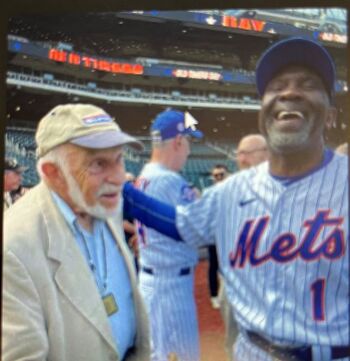 Steve Jacobson and Mookie Wilson Steve Jacobson and Mookie Wilson Mingling with the old-timers was my friend Steve Jacobson who helped cover the first season for Newsday and starred as columnist for decades. Steve, going on 89, was welcomed by Jay Horwitz, the haimish maestro of Mets alumni affairs, who also invited me as a surviving veteran of 1962. But I’m still ducking public gatherings during the pandemic, so I stayed home and waited for Steve to call me with the gossip. Steve said he wished he could have chatted with all of them, but there was such a crush, everywhere. He could have talked to Frank Thomas about hitting 34 homers and driving in 94 runs, and Ken McKenzie, who had the only winning record (5-4), and Craig Anderson, who won both ends of a May doubleheader over the Milwaukee Braves to raise the Mets’ record to 12-19 and cause manager Bobby Bragan to call the Polo Grounds a “chamber of horrors.” Oh, yeah. The Mets promptly lost 17 straight, en route to a 40-120 record. Steve also could have talked to Jay Hook, with his engineering degree, who won a game one day and told the writers it was like eating sour cherries but then tasting a sweet cherry. (All three 1962 pitchers present Saturday were part of Casey’s respected “University Men” – McKenzie from Yale, Anderson from Lehigh and Hook from Northwestern.) 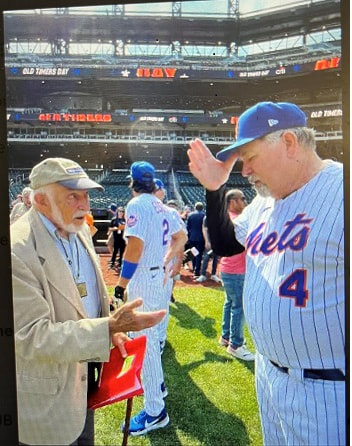 Steve Jacobson and Ron Swoboda Steve Jacobson and Ron Swoboda Steve did have time to mingle on the field, wearing a Newsday ball cap, with his wife, Anita, snapping photos of him with epic Mets including Ron Swoboda and Mookie Wilson (who later would gambol in the outfield in the old-timers’ game, along with another sleek alum, Endy Chavez.) The part that Steve treasured most was having a few old Mets tell him he had been one of those sportswriters who did not throw them under the bus when they had a bad hour on the field. We were reporters, we were critics, but we were not rippers. Now the Mets are in a new era. Steven Cohen, a grown-up Mets fan, used his money to hire Billy Eppler, Buck Showalter, Francisco Lindor and Max Scherzer. Who knows if the Mets will hold off the Braves and go far in the post-season? But gestures like the recent Keith Hernandez number-retirement and Willie Mays number retirement (honoring the jolly first owner, Joan Whitney Payson, indicate a generosity of pocketbook and heart. (Speaking of not throwing people under the bus: a few old players and writers and fans have blasted the previous ownership of Fred Wilpon and Saul Katz for not putting enough money into the franchise. I have a friend who ran a center called Abilities, Inc., on Long Island, which helps people function better in work and social life. I am told that the Wilpon-Katz family was generous with money and energy.)
Let's just say: the Mets are in a new era. I was happy to hear my friend Steve Jacobson bubble about his hours back at the ball park with similarly elderly Mets who once upon a time gave the fans so many memories -- some of them even good. We all need a momentary diversion from the 10 or 12 top terrors loose in the world.
The Mets do it for me -- playing a brand of ball I thought had gone out of style. As of Monday morning, they were tied with the Yankees for the best record in baseball. Nothing like big-market money. I think of all the years when I worked at appearing professionally neutral. Now that I am retired, I am free to watch the Mets – with two separate Met-centric smartphone message dialogues going at the same time. The Mets are so much fun to watch because they are defying the launch-angle, exit-velocity analytics trend that has rendered contemporary baseball so stultifying. It can be done. The Mets of recent years had the same bad habits of other teams – trying to put the ball over the fence and get their moon shots on TV and social media. Managers came and went – good grief, one general manager was a reforming player agent -- but New York money-guy Steve Cohen bought the team and brought in Billy Eppler as general manager and hired Buck Showalter as manager and now the Mets hitters are humbling teams with their lopsided shifts, hitting it where they ain’t, in the immortal phrase of Wee Willie Keeler. Jeff McNeil once was lost but now he’s found – propelling a home run now and then, when it comes naturally, with his good swing. Showalter is doing one of the most noticeably great managing jobs I have seen in a long time. I’m happy for him. Met him the winter before he took over the Yankees, a boy manager who had impressed Billy Martin with his knowledge as a fringe coach during spring training. Now he was getting his chance. I flew into Pensacola one morning in mid-February of 1992 and he drove me to his old neighborhood, more Alabama than Florida, introduced me to his pals at the gas station, in a town where his late father, a former Little All-American fullback and a high school principal-coach, was a legend, and then we stopped off to meet his mom. Ever after, when I was around his team, Buck he would point to me and say, “There’s George, he’s been to my hometown, he understands.” I wasn’t always sure what I understood, but, sure, Buck, sure. These days, he is a master at work in his dugout, intense, obsessive, usually with bench coach Glenn Sherlock at his side, as a sounding board. Have you ever seen coaches more alert, more pro-active, than Wayne Kirby (social director at first base), Joey Cora (performing acrobatics at third base), Eric Chavez (hitting coach, smiling reassuringly in the dugout) and Jeremy Hefner, (pitching coach, foxlike, alert to every nuance of his charges?) During the game, Showalter conducts little seminars with lifers like Max Scherzer and Francisco Lindor, while popping sunflower seeds into his mouth and making snarky comments to the umpires. Old school. Buck neglects nobody. He gets players into the lineup, before they get too rusty. He benched Mark Canha for a few days after the Mets spent more of Steve Cohen’s money for Tyler Naquin, and on Sunday Buck put Canha back in the lineup, and of course the pro responded. And for those hard-core fans, who spend their hot summer days and nights peering at the tube, it’s been a pleasure to watch the pitchers holding the Mets together when Scherzer was hurt, when Jacob deGrom was recuperating. The past week, those two aces have been back, as good as ever. Buck tried to nurse deGrom through the sixth inning on Sunday until Dansby Swanson broke up the no-hitter with a two-run homer and Buck nodded and gave deGrom the rest of the day off. It is a memorable season for Edwin Diaz, reviled in his first season in town, now having the best relief season ever seen – entering to the stirring trumpet music. On Friday Showalter recognized this was August, and they were playing the Braves, so he asked Diaz to pitch two innings and received six outs of Koufaxian brilliance. Luis Guillorme – once known primarily for having caught a wayward bat (the baseball kind) in the dugout – has been so good that Buck uses him in most days. day. Along with the Diaz entrance, the best show on the Mets is Guillorme and Lindor playing Marquis Haynes and Goose Tatum (ask your grandfather) with the ball as they trot off the field at the end of an inning. And I haven’t even mentioned Pete Alonso…or Starling Marte….or Brandon Nimmo…the other pitchers. (I am also taken with Carlos Carrasco, and his El Greco-painting serenity.) Entire odes could be written about the Mets -- and sometimes are, on our smartphone links-- during this compelling season that gives us a rest from all the other stuff. Suzyn Waldman speaks Bostonese. Chris Russo speaks Rabid Canine. Congratulations to both icons of the New York ear (and head, and heart) who have just been voted into the Radio Hall of Fame. Their endurance has demonstrated the power of the spoken (or sung) word, for people driving a car or working out or just lazing in a chair. Radio lives. And Suzyn Waldman and Chris Russo have endured for decades, from their early days on WFAN. Waldman is the radio compañera of John Sterling, the long-time play-by-play mainstay of Yankee games. Sterling, bless his heart, provides shtick and nicknames and operatic exaggeration to back up his long career of calling games. Suzyn Waldman (from Newton, Mass., and Simmons College; but you could hear that) had an earlier career in musicals – most notably playing Dulcinea in “Man of La Mancha.” Then she gravitated to talking about sports and was hired by WFAN. Was she a novelty act? She blew up that stereotype by doing what the best reporters do, on any beat. She hung out. She asked questions. And she won the respect of players, managers, coaches and the informed beat writers. From her time in the clubhouse, she knew what player was favoring a sore leg, or was in the doghouse, or had a weakness for a slider. The listener came to rely on her commentary, always politely but authoritatively following Sterling’s calls. Plus, she can follow the fickle bounces in distant corners of a stadium. Yankee fans soon realized: Suzyn Waldman knows her stuff. Not only that, but Waldman became such a moral force that she brokered a reunion between George Steinbrenner and Yogi Berra, who rightfully harbored a grudge against The Boss for having fired him. Blessed are the peacemakers, like Suzyn Waldman. Christopher Russo materialized as a sports reporter on the radio spectacle called “Imus in the Morning” – dominated by the equally brilliant and vicious Don Imus. Your ear could not miss Russo’s babbling patter that resembled Daffy Duck in the cartoons. When the station morphed into all-sports WFAN, he was paired with the opinionated Mike Francesa. (Imus called Francesa and Russo “Fatso and Froot Loops.”) In 1991, I wrote a column about Russo in which I unearthed his secret life: his mom came from England and was reportedly horrified by his diction; he had attended colleges in three different countries – England, Australia and the U.S., and before that he had attended a private school in New York State. Away from the live microphone, I detected a pleasant, centered, educated and ambitious kid who had taken speech therapy and did not mind admitting it. My headline (columnists got to write their own headlines in those days) was: “Mad Dog Is a Preppie.” He and Francesa were wired, babbling about game strategies the night before or pending trades or players who had popped off; I will admit there were times when I needed to see if the odd couple could flush out an owner or a commissioner or an agent. Nobody wanted to be hectored by Mike and the Mad Dog. It was compelling radio, in its way, as long as they lasted together. These days Russo is on Sirius. Sorry, a lot of new things like Sirius and podcasts are outer space to me. I’m a child of radio. I can still remember Edward R. Murrow scaring the hell out of me with his war dispatches from London when I was 4 and 5, and when we managed to survive that war, I found Arthur Godfrey’s jovial variety shows and Red Barber’s erudite calls of the sainted Brooklyn Dodgers. I discovered music on the radio – from Crosby and Sinatra to Aretha and Bob Marley and The Band and Dolly Parton, disk jockeys from the long-ago Jack Lacy on WINS-AM to William B. Williams on WNEW-AM (until I heard him destroying a vinyl record, live, on the air, by some new shaggy-haired kids from Liverpool.) Radio: Garrison Keillor, NPR, Jonathan Schwartz and Peter Fornatale on WNEW-FM, the doomed classical station WNCN, and nowadays an upgraded WQXR-FM particularly Terrance McKnight from Morehouse, 7-11 PM weeknights, the eclectic John Schaefer on WNYC and the great interviewer Brian Lehrer, WNYC, both AM and FM. Baseball? It was invented for the radio, or vice versa, never more than when the grubby forces of Major League Baseball condemn Mets or Yankee games to other networks. Radio is a vibrant medium, all on its own – and Suzyn Waldman and Chris Russo are deservedly in the Radio Hall of Fame. Ever since Roger Angell passed last week, friends have been e-mailing about how great he was, and asking how well I knew him.
Let me say, he was grand company in a pressbox watching a game. I always thought he seemed liberated by his mid-life discovery, his strange hobby, writing about baseball. It began as his left-brain, right-brain activity, when he wasn’t editing temperamental fiction writers or conducting in-house business at the New Yorker or dealing with the vicissitudes of life. He enjoyed the hell out of this other world, and it showed. He also loved paddling his kayak or sailing along the Maine coast when he wasn’t writing about Pete Rose or Reggie Jackson or the baseball denizens of the Pink Poodle, his hangout in Arizona during spring training, or editing what any sportswriter would respectfully call “real writers.” Now and then, he would pop into Yankee Stadium or the Mets’ ballpark, without the weary pack-mule trudge of the beat writer or old-fashioned sports columnist (been there, done that) lugging a laptop, expected to produce profundity on deadline, halfway through the season, 81 up, 81 to go, plus the endless autumn trek. As we all said in our alibis for why we were not Roger Angell: we had deadlines. While we were pecking away, he could hang back and chat up a ball player who grasped that this older guy knew the game and was not looking for a few quick quotes. I admired the working friendship he developed with, let’s say, Dan Quisenberry, a submarine-style relief pitcher with the Kansas City Royals, who was cool enough to explain his technique. Roger also took seriously the first female writers in the press box and – gasp – the locker room, who were professionals, just like men, if you can imagine. So, how well did I know him? I got off to a dumb-ass start. It must have been 1968 when I sat next to a guy near 50 and we introduced ourselves and he said something about “New York” and I thought he meant the new weekly magazine so I wished him luck with the new publication. To his credit, he did not correct me, nor did he back away from this dolt. Later I deduced that he wrote for the New Yorker and began subscribing, not just for his occasional baseball pieces but for the great eclectic literacy of the magazine. I still subscribe to the New Yorker in the age of Editor David Remnick – a great guy who started as a daily sportswriter, for goodness’ sakes. The arrival of the New Yorker—the print version – is a highlight of this pensioner’s life. Did I learn anything from Roger Angell? The best part was the way he thought independently and observed the sub-marginal things and had the time and space and license to elaborate. Plus, he had talent -- could play with themes and details, knowing exactly what he was doing. He was a model, but then again, in our collective world, no journalist should lack for models. My parents were journalists and I came along in the pioneer Newsday sports department in the 60s, with crusty old editors and the new breed of chattering younger types, known as Chipmunks. And then there were books that made me want to write longer and better. In the early 60s, I sought out “Bull Fever” by Kenneth Tynan, a London drama critic who roamed to the corridas of Spain, or “Cars at Speed,” by Robert Daley (son of the noted Times columnist, Arthur Daley), who had bolted to Europe to write about the Grand Prix – and life in the old world – and ignited my wanderlust. In the same period, I read “Night Comes to the Cumberlands,” by Harry Caudill, a lawyer from an old Kentucky family, whose lament for the defaced mountains made me want to go to Appalachia and see what was left. So many great writers, out and about, dealing with current issues, from their heart, from their eyes, from their brains, writing at entertaining length. Over the decades, I was always happy to spot Roger Angell in the press box. I cannot remember what we talked about, but it was fun. When I retired at the end of 2011, I kept up by phone when I particularly loved something he had written, and I called when he had a death in the family. When my wife and I started visiting her elderly uncle in coastal Maine, I called to tell Roger how much we loved his other world. My wife says I should have told him that some Angells popped up in her sprawling family tree from New England in the 17th and 18th Centuries. Finally, a confession: Every year, readers would look for Roger’s annual Christmas poem, hailing and pairing people with exotic and yet topical names. For decades, every December, I scanned the poem for my name, but it never appeared. I never told him how sad I was. Other than that, Roger Angell was, just as you imagined, great company as well as great reading. * * * In case you missed: Obit by Dwight Garner: https://www.nytimes.com/2022/05/20/sports/roger-angell-dead.html Tyler Kepner’s appreciation: https://www.nytimes.com/2022/05/23/sports/baseball/roger-angell.html And a labor-of-love sampling of Roger’s work, from Lonnie Shalton, lawyer in Kansas City and a true lover of baseball: http://lonniesjukebox.com/hot-stove-192/ I worked myself into a tantrum last Friday when Max Scherzer was making his first start for the Mets. I wanted to see the game, plus hear what the Mets’ knowledgeable TV triumvirate of Cohen-Hernandez-Darling had to say about it. Then I found out that Major League Baseball had farmed out this game to some Apple outlet, with unfamiliar broadcasters. Yes, the very same Rob Manfred operation that now welcomes gambling commercials. (Coming next year: commercial patches on uniforms. Baseball goes Nascar.) I knew enough to instantly switch to Good Old Howie Rose, of course – baseball is a great sport for radio, with lifers like Rose -- but people who could not access WCBS-AM radio (upstate New York, for example) were stuck with the gimmick -- noisy strangers hawking silly “probability” statistics but clueless about the daily workings of the Mets. Baseball clearly has no shame. * * * Totally by coincidence, I have been reading a biography of one of the great baseball broadcasters of all time, Red Barber, who introduced my brain, my heart, my ears, to the Brooklyn Dodgers, starting in 1946. My earliest baseball memories are riding around Queens with my father, with Red Barber on the car radio, and listening to night games in our back yard, via a radio that occasionally emitted shocks from a faulty connection in the garage. Red Barber’s melodic southern accent calling a Jackie Robinson foray on the third-base line, on a warm summer night, outdoors? The best. Later I got to know Red in the Yankee Stadium press room, in the 60’s, after he had switched over to the “big ball park in the Bronx” – his alliteration, not Mel Allen’s. Walter Lanier Barber had respect for the game itself, and for the intelligence of the listener, and for the rules and codes of life. I did not know, back then, that Barber was also a lay preacher, but what I did know was that he stood up for the right thing, by his standards, and he offered a measured response when things did not go the Dodgers’ way. He was not an overt rooter, did not refer to ”we,” did not make excuses for Dodgers. On the final day of the 1950, the Dodgers had Cal Abrams thrown out at home, and then lost the pennant on a home run by Dick Sisler. I can remember listening in my family house, as Barber delivered what I took as a sermon of sorts, that life would go on, there would be another season. It helped me get through another Yankee World Series – a piddling issue, to be sure, but he gave hope; there were more important things in life. Now I know Red Barber better, through a valuable new book, “Red Barber: The Life and Legacy of a Broadcasting Legend,” by Judith R. Hiltner and James R., Walker, published by the University of Nebraska Press, which often issues serious sports biographies and histories. Red Barber deserves this adult biography. The book takes me to Barber’s southern childhood, his hard-working father and idealistic mother, a very segregated world, and even Barber’s youth as an entertainer doing – gasp – minstrel music, mimicking stereotypes of Black music. As the young and very ambitious man, morphed into a broadcaster, he was lucky to be instantly taken with a young nurse named Lylah Scarborough, also very southern, but with a difference: she had played with Black children, and had treated Blacks in her profession. The book shows how Miss Lylah prepared Barber to adjust to the advent of Jackie Robinson in 1947, and also to enjoy the culture of the city. He never denied it: he was a work in progress, with help from his mother and his wife. Barber broadcast many sports, eventually on national networks, but his specialty was baseball, first in Cincinnati, then in Brooklyn. He had a code: he could drop folksy sayings (“rhubarb,” “catbird seat”) in his southern cadence, but he had to remain an adult on and off the air. He took his cue from his father, fighting for better contracts; he also learned from Branch Rickey, the innovative, educated and religious boss of the Dodgers. Barber knew he was speaking to Dodgers’ fans but he did not root – was not a “homer,” in the press-box slight. He also did not go along with certain broadcasting ways: calling the 1947 World Series, he told the national audience that Bill Bevens of the Yankees had not given up a hit with two outs in the ninth. The superstitious blamed Barber after Cookie Lavagetto broke up the no-hitter but Bevens assured Barber, heck, it was Bevens’ own fault for walking so many hitters. When a new owner named Walter O’Malley took over the Dodgers, Barber continued to tell the truth. Once he informed the radio audience that the opposing infield was playing deep for a double play because Carl Furillo, the Dodgers’ stalwart right fielder, was notoriously slow. Any true fan knew that already – the great Dick Young had labelled Furillo “Skoonj,” a slang Italian reference to snail -- but O’Malley dropped a snide remark on Barber the next day. Not long afterward, Barber was calling Yankee games, remaining his own man, once noting the sparse crowd (413 paid) for a late-season Yankee game. More broadly, as the book emphasizes, Barber’s austere presence became out of style. Time to move on. Barber spent his final decades back in Florida, still a national figure, from his Friday morning NPR “Morning Edition” conversations with Bob Edwards, plus writing and speaking and eventually caring for Miss Lylah when she developed Alzheimer’s. He died in 1992 and she in 1997. Sports broadcasting has continued to evolve. I would submit that the booth of Cohen-Hernandez-Darling bristles from the individual gifts of all three, starting with honest calls from Cohen and his enlightened questioning of his booth mates -- former ballplayers, a genre that Barber disdained. Hernandez offers the perspective of a fiery on-field leader and Darling offers the perspective of a Yale star who does his homework. My guess is that Red Barber – who was always looking for another protégé like Vin Scully -- could have worked with all three of them. Baseball fans will enjoy this serious biography of an evolving adult who set a high standard for broadcasters, players and fans. Red Barber could get excited. Here is his classic call of the game-saving catch by Al Gionfriddo in the 1947 World Series -- watch Joe DiMaggio make a rare show of frustration. Barber's exclamation of "oh....doctor!" was not a stock phrase of his. He just blurted it.
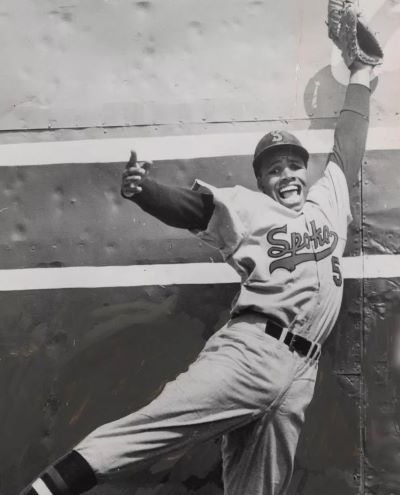 Tommy Davis in his short stint in minors at Spokane. Tommy Davis in his short stint in minors at Spokane. Tommy Davis always remembered where he was from. Whenever the Mets would play in Los Angeles, the assorted chipmunks and walruses of the large NYNY media corps would tromp over to the Dodger clubhouse to schmooze with the team that used to play in Brooklyn. As soon as he sighted familiar faces – or heard familiar Noo Yawk accents – Tommy would turn to his teammates and announce: “Hey, these guys are from my hometown.” And he would chat with reporters about one thing or another. Tommy Davis was always a New Yorker at heart This comes across in the lovely obit in the Times, by Glenn Rifkin, that describes Tommy and Sandy Koufax celebrating with a made-in-Brooklyn victory dance in the clubhouse after a 1-0 victory. One thing that would always come up – that is, I would bring it up – was the damage Tommy did to one of my best friends from school. It went back to March of 1956, in the PSAL basketball playoffs, then held in the old Garden between 49th and 50th streets. Tommy was one of the mainstays of the Boys High team (now Boys and Girls High) and he showed an eye fore talent by cajoling his pal Lenny Wilkens, a feathery guard, into playing one semester for Boys, but Wilkens --now a Hall of Fame pro player and coach-- was out of eligiblity by the playoffs. In a second-round game, Boys was playing Jamaica High, the defending city champion from 1955. One of the Jamaica regulars was my pal since the seventh grade, Stanley Einbender, a very solid forward. Stanley was waiting for a rebound when, from the upper stratosphere of the Garden, came Herman T. Davis, Jr., of the Bedford-Stuyvesant Davises. On his way downward Tommy happened to clip Stanley on the forehead, producing blood, and requiring Stanley to leave the game for medical attention. Boys won -- it would have won anyway -- and Stanley became the rock of a great Hofstra team from 1957-60, with a not very noticeable scar on his forehead. Later he became an endodontist and we are friends to this day. In our 20s, whenever I ran into Tommy – particularly in the Dodger clubhouse, with other Dodgers listening – I would tell the tale about how he clobbered my pal in Madison Square Garden, and that my friend was now a dentist looking for revenge. Tommy loved that story. Tommy Davis showed great perseverance in playing on, after a gruesome broken ankle while sliding when he was a young star. His gait was affected, but as the obit notes, the designated hitter rule, that began in 1973, kept him in business. Whenever I got too snooty about the DH being a “gimmick,” I thought of Tommy Davis struggling to run the bases, and I toned it down a notch or two. They never met, but one wintry Sunday a decade ago, Tommy was in Queens, at a memorabilia show, signing his autograph. I greeted him, and ostentatiously took out my cellphone and called Stanley, an hour east on the Long Island Expressway and said, “Here’s your chance.” But Stanley couldn’t make it, for one reason or another. I would have loved to be there for a second meeting of these two brothers of the backboard. * * *
AN APPRECIATION OF TOMMY DAVIS (AND BROOKLYN) FROM MY FRIEND JERRY ROSENTHAL (great shortstop at Hofstra, Madison High and Milwaukee Brave farm system): George, thanks for remembering Tommy Davis, one of Brooklyn’s greatest athletes! I played against Tommy in the Parade Grounds League back in the mid-50’s. Tommy played center field on the Brooklyn Bisons, alongside Lenny Wilkins. I played third base on the Brooklyn Avons. My James Madison High School teammate, Teddy Schreiber played shortstop on the Avons. Those were the halcyon days of amateur baseball in Brooklyn. The Dodgers were going strong and baseball was the only game in town! Life was good! The Parade Grounds is located adjacent to Prospect Park. In those days, it was made up of of 13 diamonds which were fully occupied on weekends - from 8 AM to 6PM. Diamonds 1 & 13 were the showcase fields usually featuring the best senior division teams ( ages 16-18 ). Sometimes a playoff game would draw up to two thousand fans along with a dozen scouts. The Bisons were a long established Black team in the Parade Grounds. Make no mistake about it, there were no integrated teams back in the 50’s! However, the Bisons did have a few white ballplayers on their club. How ironic! After my final high school season in 1956 , I was invited to Ebbets Field to try out for the “Brooklyn Rookies,” a promotional team that traveled around the Metro area playing highly rated amateur teams. Davis had already signed and was playing at Hornell , N.Y. in the New York Penn League. I didn’t make the Dodger Rookies team which was a major disappointment! However, two weeks later I was invited to attend a tryout at the Polo Grounds. Willard Marshall, the scouting director of the hated New York Giants, asked me if I was interested in signing a class D contract. I was thrilled by the offer, but college was in the offing. As a minor leaguer in the Braves organization (61-63 ) the only guys I followed in the Sporting News were Tommy Davis, Koufax, Joe Torre, Bobby Aspromonte and Joe Pepitone, all Parade Grounds alumni. While playing for the Yakima Bears in ‘62 in the Northwest League, I realized that Tommy was having an incredible year with the Dodgers! .He looked like the second coming of Willie Mays! Another great year in 63’ and then the devastating broken ankle injury. What a tragedy! The lack of recognition and the gross underpayment of Davis was emblematic of the way ball players were treated before the monumental efforts of Marvin Miller and Curt Flood! I wish today’s MLB players were more aware of the history! The fact that Tommy hung around the major leagues for another 13 years, shuttling from one club to another is testament to the toughness and resiliency he developed back in Brooklyn on the hardscrabble fields of the Parade Grounds. Best, Jerry The terrible stuff is all over the news but baseball, as always, is a welcome diversion. It was on television and good old the radio this weekend. Pick your team; mine is the Mets. I make no apologies for the hours I spent following Good Old Howie Rose on the radio for two days and the Three Amigos on the tube on Sunday. The Mets presented their first exhibition Saturday, with Rose back in the booth after shutting down last season because of illness. He sounded himself in his haimish Queens tones (so familiar to my central Queens ear.) Rose and his radio sidekick, Wayne Randazzo, noted that spring training was delayed to mid-March as the hard heads of Major League Baseball nearly throttled their thing, but now MLB is going after all that good, clean gambling money, while clubs are playing catchup – opening days in less than three weeks. As the Mets played the Washington Nationals in West Palm Beach, Rose and Randazzo discussed the big change in rules this year – the National League has gone the way of the designated hitter after 49 years of the gimmick solely in the American League. (The New York Times has an interview with Ron Blomberg, the first DH for the Yankees back in 1973. Blomberg likes it, and why not? It is his claim to fame.) Somewhat to my surprise, Rose, 69, said it was time for “traditionalists” to accept the DH. Most pitchers can’t hit, anyway, and even those who can are in danger of being injured by putting their hands and wrists and elbows in the way of a wayward pitch. The deGrom Argument. Jacob deGrom has been my best reason for keeping the tradition, based on the good hitting pitchers over the decades – Don Newcombe of my Brooklyn Dodgers, Bob Gibson, Don Drysdale, Tom Glavine, Madison Bumgarner. (Shohei Otani, the slugging pitcher, is not just from Japan; he is from some other planet entirely.) However, deGrom is also the best argument for getting elite pitchers out of harm’s way. He was an infielder in college and is a lithe fielder on the mound, and he can also bunt and swing for power. He kept getting hurt last year, ending his season way too early, possibly because of the stresses of hitting a fastball with a wooden bat. Who wants to see Jacob deGrom’s career end early? Howie Rose was spot-on, in the opening innings of the first radio exhibition of the spring. This traditionalist gives up. I picked up the Mets’ Sunday game on television, from their camp in Port St. Lucie – Gary Cohen, Keith Hernandez and Ron Darling, warming up for their 17th season together – so savvy, so entertaining. Their show showed a clip of Lindsey Nelson doing an intro for the Mets’ historic first camp in 1962, and praised the earlier Three Amigos, Nelson and Bob Murphy and Ralph Kiner. The current Amigos let us know winter was truly over by discussing the free agents who have moved around for salaries that seem unbelievable to me. They also discussed the legacy-killing act of Robinson Cano, who is back from a second drug suspension, the knucklehead. The Amigos also talked about how clubs have to prepare fast. Hernandez, that great first baseman, noted that Francisco Lindor has a bad habit of underarming his throws on slowly-hit grounders. They speculated whether Michael Conforto could still be signed for this season --- a really good point, since he seemed a victim of the Mets' organizational anarchy last year. And Cohen, who flew to San Diego to fulfill his winter gig with Seton Hall basketball, raved about the stunning double victory by fellow jersey school, St. Peter’s. 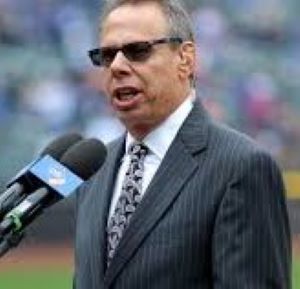 Welcome Back, Howie Rose Welcome Back, Howie Rose True confession: just like the ball players, I am not ready to go nine, so I dozed in mid-game and caught the last segment on the radio with Good Old Howie Rose. He was talking about the deterioration of most of the Mets’ hitters last year, as the old-time batting coach, Chili Davis, got fired, replaced by two minor-league coaches, who, according to Rose, were undercut by analytics types going where they don't belong – buzzing in the ears of major-league hitters. That won’t happen again, Rose said, and I hope he’s right. In the final innings, Rose noted that the new manager, Buck Showalter, re-arranged the batting order of the anonymous late-inning subs, and imitated Bob Murphy, who used to explain the machinations of Casey Stengel or Bobby Valentine by enunciating, “I’m….sure…he…has…his... reasons.” “Come on, April 7,” Rose urged, referring to Opening Day, when the March of the Subs will no longer happen. He observed the fans, making their getaways into the choke point on the dreaded Peacock Blvd. Randazzo said he knows a short cut, albeit illegal, through a nearby gas station – the late-inning preoccupations of spring training. All seems normal. Welcome back, baseball. ---- * -- Homage to the Terry Cashman standard. And for all radio baseball fans: Maybe it’s the pandemic, but people seem to be forgetting the dangers of alcohol and gambling.
I base this on the recent approval of gambling outlets in New York State plus the avalanche of gambling advertisements on baseball broadcasts in the reign of Commissioner Rob Manfred. Um, does the name Pete Rose strike a familiar chord? Last I looked, that sick puppy is still banned for doing what the alluring TV ads urge people to do – bet the rent or the grocery budget on the wayward bounce of a baseball with Rob Manfred's signature on it., And the dangers of alcoholism seem to be minimized by a new movie directed (not produced, as I originally wrote) by, of all people, George Clooney, for whom I have high respect. Clooney has sent forward a movie, “The Tender Bar,” adapted from a fine book by J.R. Moehringer about his exposure to alcohol as a very young man, admiring his bartender uncle and missing his absentee father, leading to his eventual admission of powerlessness toward alcohol as an endangered adult. “The Tender Bar” movie is being hawked every couple of paragraphs on my incoming Web glut. I get the point. Little kid, hanging out in a pub, gets pulled into the life. I was tempted to push the button to watch the movie on my laptop, but then I read two rather different reviews of the movie in The New York Times. Critic A.O. Scott suggested the movie is lightweight, skipping from episode to episode: “Ít’s a generous pour and a mellow buzz.” But free-lance critic Chris Vognar takes a more critical look at the dangerous slide of a young man, made clear in the original book. Vognar writes: “…for a film with the word ‘bar’ in its title, it contains remarkably little insight about alcohol, where it’s consumed, and what it does.” The two critics talked me out of watching. Why, you ask, do I take gambling and drinking so seriously? I’ve seen gambling up close and have great respect for people who seek out Gamblers Anonymous and reinforce themselves, regularly. I have also seen alcoholism up close, having helped Bob Welch write his book, “Five O’Clock Comes Early,” about how he was having blackouts in his early 20s, jeopardizing his pitching career with the Los Angeles Dodgers, to say nothing of his life. By the time I signed on for his book, Bob was already sober from a hard month at a rehab center, and he was an advocate of daily reminders to stay sober. I later spent a family week at the center, and took a great deal from the process, from seeing endangered lives be turned around. Bob knew the dangers, and he verbalized them – part of the process. “I choose to be sober today.” As far as I know, he stayed sober for the rest of his life, which ended tragically young, 57, from an accident. Now I have a close friend who reminds himself daily how he, and Alcoholics Anonymous, saved his life. Why do these reviews of “The Tender Bar” strike close to home? As it happens, I live close to Moehringer’s home town, and have spent too many long minutes waiting for a red light to change, staring into the silhouettes in Moehringer’s pub. Plus, I have known several relatives of Moehringer, and have been apprised that he was not exaggerating his childhood. His book was great; I’ll skip the movie. Now, back to gambling. We all know how much money is gambled on sports, every day, everywhere. (The first college game I ever saw in the old Madison Square Garden was a dump, Kentucky stunningly losing to Loyola of Chicago.) I consider “Eight Men Out,” about the Chicago White Sox players who dumped the 1919 World Series, to be the best sports movie I know. Gambling did not go away when Pete Rose got busted for betting on baseball, including games in which he participated as manager (and, I am sure, as player.) I remember how the late baseball commissioner, Bart Giamatti, adamantly criticized all gambling --- including government-run lotteries. For Major League Baseball to permit gambling ads is dangerous; for New York State to permit gambling sites is also dangerous. (For that matter, I see that The New York Times, that great newspaper, is spending a ton of money to acquire a website, “The Athletic,” that is heavy into gambling odds. How does that impact the parent company when gamblers make or lose money via odds listed in that outlet?) We have a social brain fog that accepts drinking as a mellow haze that can be controlled, that encourages people to bet on capricious games. Then again, we see dopes like Novak Djokovic and Kyrie Irving and Aaron Rodgers misleading and blustering about vaccinations. Plus, an entire political party is going along with thugs invading the Capitol. Can we blame the pandemic for all this? Is this the World Series that is going to take baseball down?
I ask this as a certified Old Guy who has been following the World Series since 1946 (I was quite young) when Harry (The Cat) Brecheen, a wiry lefty, pitched 20 innings and won three games for the Cardinals. Pitchers were epic back then and remained so until the past decade when almost all of them became spear carriers in an opera that drones on, too long, every night. (And it’s not totally the fault of Joe Buck and Fox, either.) In the formerly showcase season-ending event that once saw Deacon Phillippe of Pittsburgh pitch 44 innings and win three games in 1903….and Bob Gibson of St. Louis pitch 27 innings and win three games in 1967 ….and, as recently as 2014, Madison Bumgarner of San Francisco pitched 21 innings and won two games. Seven years later, pitchers are interchangeable, and mostly forgettable, used by managers and coaches who burn to win, and know their game and their players, but are under the un-calloused thumb of mysterious analytics wizards, chained in the laboratory, coming up with numbers that general managers (and club owners) pay for and force upon their managers. The result is two pitching staffs of spare parts, not a commanding figure among them. To be fair, I love some players on both teams -- the miniature second basemen, Altuve and Albies, the Old Reliables, Brantley and Freeman. As good as it gets. But gone is the epic figure on the mound , the center of the action. After five games – the shuttle resumes Tuesday night in Houston, with the Braves up, three games to two – the pitching staffs are mutually anonymous. The most innings by a Braves pitcher is 5.1 by Kyle Wright who pitched most of the season for the Gwinnett farm team in the Atlanta region. The most innings by an Astros pitcher has been tossed by Jose (Hombre de Acero) Urquidy – a massive total of 6. Urquidy also has 2 victories – but may not be remembered along with Bob Gibson, who on the final weekend of the 1964 season pitched eight innings (and lost to the Mets) and then gutted his way through 4 innings on Sunday to help the Cardinals nail down their first pennant since 1946. I remember. I was there. I can still see Gibson on the stairs to the players-only loft. “Hoot, how’s your arm?” a reporter asked. “Horseshit!” Gibson bellowed. After that game, kindly Manager Keane was asked why he went so often with a fatigued pitcher. “I had a commitment to his heart,” Keane said softly – one of the most touching answers I have heard in decades of sports interviews. Gibson then started the second game of the Series and pitched 8 innings and lost, and won the fifth game in 10 innings) and then won the seventh game in 9 innings to ice the World Series. He had pitched 56 innings in 22 days Is this sort of super-human out of stock these days? Have the hitters become so bulked-up, so fearsome, that statisticians dictate pitching changes, while a rank smell of fear permeates the ball parks? Is this the reason baseball has the feel of an ancient ritual, that appeals mostly to geezers with memories, like me? Part of the problem is the glut of commercials and other baseball promos between every inning. And the television production is numbing, with statistics for “post-season” accomplishments being flung at the viewers with no context and no compelling narrative. Joe Buck is plastic and John Smoltz, while he surely knows the game, is humorless. I’m an early person anyway, and I dozed here and there, but for the fifth game I switched to radio,with the TV on blessed mute. The ESPN crew of Dan Shulman, Jessica Mendoza and Eduardo Pérez was vastly better – more interplay and humor and even disagreement, plus expertise (Mendoza was an Olympic softball star, Pérez played over a decade in the majors. Vastly better. ESPN is 98.7 on the FM radio in the New York area. Nevertheless, the World Series lacks star pitchers who command attention. No Christy Mathewson, no Smoky Joe Wood, no Mickey Lolich, no Randy Johnson. You want a plot? You want drama? Go watch baseball, in the international spotlight, throttle itself. Let’s get this straight. Think of the Houston-Atlanta matchup as the World Series – an event unto itself -- not the end of a long and grueling tournament. Think of the World Series when it stood alone as a treat, a dessert right after the regular season, in sunshine – bright or hazy – rather than a late-night marathon with people on the East Coast dozing off. (Me! It’s all about me!) The recent games, as good as some of them were, have been bloated with post-season statistics, most of them irrelevant. For the next four to seven games, everything that happens should be compared to derring-do performed by players like Babe Ruth, Tris Speaker, Frankie Frisch, Whitey Ford, Yogi Berra, Duke Snider and Mickey Mantle. While we’re talking about wretched trends, have you noticed the commercials for gambling dens, gambling sites? I mean, how could you not? At least, the commercials for Caesars gambling world are interesting, with a cool latter-day Caesar giving the people a spectacle. The gambling commercials play into the weaknesses of thousands, millions, of people who come to life only when their money, their lives, are tied into the action – pitch by pitch, by dancing roulette balls or actual pitches thrown by Major League Baseball. The commercials do not show the after-effects of people betting the rent money, the food money, school tuition money, and skulking around, unable to admit they have a gambling jones. The last time I looked, Pete Rose is still banned from baseball for gambling on games (including ones in which he may have managed or played.) Rose, the dope, also stonewalled Commissioner Bart Giamatti, who seethed with anger and died of a heart attack a few days later. Under Rob Manfred’s “leadership,” baseball is sanctimonious about gambling because it needs the TV commercial money because baseball is falling behind other sports. (When I am watching Liverpool-Man City on the tube, I can tell my wife it will be over in two hours.) Baseball is also falling behind other sports because it has become bloated with pitching changes and rituals like adjusting wristbands (and private parts), plus the ball is in play less and less. The new analytics dictate “strategy” involving shuttling pitchers in and out of games, batters swinging for “exit velocity.” However, a good sign is that the better teams – the ones we are seeing in October – seem to remember old-timey tactics –the occasional hit-and-run, the professional sacrifice fly, the stolen base. My friend Jerry Rosenthal is enamored with the Atlanta Braves, for good reason. Jerry played two years in the old Milwaukee Braves farm system, with mentors like Dixie Walker, Andy Pafko and Jim Fanning, and he played against Bobby Cox in the minors, and decades later he chatted with Cox at the Mets’ ballpark. He says the Braves and Manager Brian Snitker have never stopped inculcating players with traditional skills and tactics. “Snitker is a clone of Bobby!” Jerry wrote in an email. “He has the fine human qualities that a great manager must have! I think the whole process comes naturally to this ‘old salt’ who learned his trade by managing in the minor leagues for many years, just the way it was when I played!” Jerry added: “If this series with the Dodgers doesn’t teach these new-age numbers savants that the game is played on the field, nothing will! The consistency of the Braves defense is remarkable! Everyone does their jobs in a workman-like fashion. No outsized egos in sight! “The concept of ‘picking-up’ the guy who didn’t get it done is evident in the Braves’ approach! Put the ball in play, move that runner to third base, steal a base, etc.! I love it!” The Astros have stayed mostly intact as fans haunted them with reminders of the sign-stealing scandal four years ago. I can’t help enjoying that team that was so much fun a few years ago, although I miss George Springer. To get to the point, how does a neutral fan, like me, choose between the Braves or the Astros? When I was working, I rooted for the cities of San Francisco and Oakland mainly for the ambience of the Bay Area, or Boston, for the October walks. But now, my standards are different. The Dodgers have been gone from Brooklyn since after the 1957 season so during this year’s wild-card playoff I immediately rooted for the Giants because of one player, Wilmer Flores, known affectionately as Weeping Wilmer for the way his emotions flowed the night he heard rumors the Mets had traded him. (It was subsequently called off.) This year, Wilmer was at the plate with two outs in the ninth, and Ron Darling (who made the TBS broadcasts so good) told the audience that Wilmer was a clutch hitter with the Mets. Just then, Wilmer was called out on strikes while trying to check his swing. After seeing the replays, I think Wilmer and the Giants were screwed, but we have moved on, haven't we. I had no problem with Mookie Betts and the Dodgers, or the team representing the great city of Boston, and as a Mets fan I liked the Braves of Chipper Jones and Bobby Cox, and I like this team, with Freddie Freeman schmoozing with everybody who reaches first base, plus unglamorous old school manager Snitker. But now we’re in the World Series; remember, it’s a separate entity, no matter how many "post-season" stats Fox shovels at us. I find myself gravitating to Houston – that very contemporary American multi-cultural city -- because of the manager, Johnnie B. Baker, Jr. Dusty was mentored by Henry Aaron and later was like a big brother to my late friend Bob Welch, a star pitcher with the Dodgers in the early 80s. Now he has been a good manager with five different clubs. Baker was profiled by Tyler Kepner, the Mister October baseball columnist of the NYT, who pointed out that Baker now holds the record for most games (1987) won by a manager without winning a World Series. Baker, true to himself, acknowledges that he was aware of that “distinction” during the league series, and he will surely be asked about it during the World Series. He can handle it. I’ve been around Dusty during part of his managing odyssey with the Giants, Cubs, Reds, Nationals and the Astros, and I also heard about him through my pal John McDermott, master photographer, now living in Italy, who knew him in the Bay Area. “Dusty has a great family,” McDermott reports. “His son Darren plays on the baseball team at UC Berkeley” – a reference to the son-of-manager junior batboy who wandered too close to home plate during the 2002 World Series. “He has a wine company, Baker Family Wines: and an energy company, and is good company.” John knows Dusty via a fellow Bay Area photographer, Terry Heffernan, a fishing buddy of the manager. "Dusty is many things: smart, wise, emphatic, loyal, fierce, a giver, consistent, quick to smile, a lover of life… a true friend, the real deal!" Terry emailed me. He added: "Its easy to talk about Johnnie B Baker Jr. If we all rolled like he does, our world would look very different! "GO ASTROS… and hopefully Mr Baker will break the managerial Hall of Fame color barrier!" I’m retired. I don’t have to profess neutrality. All due respect to Atlanta, I’m rooting for Houston, mainly because of Johnnie B. Baker, Jr. On the morning after, what are your reactions to the wild-card game Tuesday evening? (I notice one of our regulars, in the Comments section, is celebrating the 6-2 loss by the Brooklyn Dodgers' old tormentors.)
* * * "Red Sox-Yankees: As good as it gets." I heard myself – steadfast Brooklyn/ Mets/National League fan – uttering those words when the Red Sox and Yankees wound up in Tuesday’s wild-card game. It really is baseball’s classic matchup -- between two teams that have never been mine. I’m old enough to remember being at Jones Beach, middle of last century, and hearing stereophonic portable radios blaring Joe DiMaggio drubbing Ted Williams, over and over again, an endless summer of Mel Allen, blaring from blanket to blanket. When I became a sportswriter, I rooted (unofficially, of course) for the underdog Red Sox but there was always a Bucky Dent or an Aaron Boone. I have never been a Red Sox fan, per se, but I loved the city of Boston from my first trip there in 1962, and I used to think maybe someday we’d live there. And Fenway Park – the wall, the deep right-field stands, the skyline, the immediacy of that great city. A ball park, a city, worth rooting for. I was rooting for the Red Sox on Oct. 5, 1978, when the two historic teams met in a one-game playoff. We had driven our oldest child to visit a college in the Northeast, and while she and my wife were taking a tour, I sat in the car and listened to Russell Earl Dent morph into Bucky Freaking Dent. Who doesn’t remember those autumnal mood swings that baseball does so well? This past week has aggravated the angst for aging fans of the Boys of Summer. We remember Oct. 3, 1951, when Bobby Thomson of the New York Giants drilled a home run into the left-field stands of the Polo Grounds and into collective memory of Brooklyn Dodger fans. I remember coming home from junior high and hearing the terrible deed—and wandered outside to pick a fight with a much larger Yankee fan in the neighborhood. A friend asks: why fight Bluto? That was the point. Being a Brooklyn Dodger fan was masochistic, by definition. My pal Jerry Rosenthal was a Brooklyn kid. When Thomson smote Ralph Branca, Jerry recalls, he cried for two days. (When Jerry played ball in the minors, his hitting coach was Pafko-at-the-Wall. They talked lovingly about Brooklyn.) Talk about memory. George Hirsch, one of the founders of the New York City Marathon, wrote about his memories – how he and some buddies came down from suburban New Rochelle to watch the game. Hirsch wrote about it for the New York Times last Sunday, and he also appeared on CBS Saturday morning: https://www.nytimes.com/2021/09/30/nyregion/70-years-later-bobby-thomsons-homer-still-hurts.html https://www.youtube.com/watch?v=rMprziU_xok The Dodgers and Giants formed the great baseball rivalry, but that was then, in a different New York. Those two teams moved to California and broke a lot of hearts, including mine. To be sure, they remained rivals. I was in the press box in Candlestick Park in 1965, when Juan Marichal clubbed John Roseboro over the head at home plate – as ugly as it gets. Then there's this: the Yankees and Red Sox never left town. Gotta give them that. In 2004, the Yankees drubbed the Sox, 19-8, for a third straight victory in the AL series. I will never forget being in that tiny Red Sox clubhouse and hearing Johnny Damon say (and I am writing from recall): “If I am not mistaken, we won four straight games eight times this season.” His point was: they could do it again. And they did, beating the Yankees four straight and then the Cardinals four straight in the World Series for their first championship since Babe Ruth and 1918. The Red Sox’ four straight victories over the Yankees in 2004 is now part of their rivalry – payback, as good as it gets. There, I said it again. (In a world of Kabul, Covid and Ida, the following is totally irrelevant. But this is what I know.)
* * * (The Thumbs Guys "apologized" and the Mets won a doubleheader on Tuesday, the first with a stunning rally. But the basics remain. My friend, once a prospect with the old Milwaukee Braves' franchise, keeps up with the business, and gives his view of the Mets' problems:) From Jerry Rosenthal: George, your fine piece should resonate with angry Mets’ fans! This latest debacle was inevitable! The toxic duo of Lindor and Baez split the Mets’ clubhouse that was once led effectively by Jacob deGrom! Steve Cohen made a huge mistake in signing Lindor for over $300 million! However, picking up Baez, a known malingerer and “all about me”ball player is Sandy Alderson’s mistake! The imperious Mets’ executive never seems to get criticized by the press for the poor construction of this Mets roster and senseless trades. The Mets gave up a top outfield prospect to get Baez just for a “short-term rental.” Alderson went for a home run hitter like Baez, ignoring the fact that he could easily strike out four or five times in a game! Obtaining Baez brings to light the fallacy of the “money ball” philosophy! All season, the Mets were waiting for that home run that never came at the right time! It was all about the long ball! Putting the ball in play with two strikes was not in the Mets’ playbook in 2021. Alderson fired respected batting coach, Chili Davis who was an advocate of using the wide expanse of Citi Field to the hitter’s advantage! Chili emphasized the importance of trying to hit the ball in the alleys and using the fundamentally sound hitting approach of “hitting through” the ball and making solid contact, rather than trying to “lift” the ball in the air! Chili’s smart hitting advice was abandoned under the new “hitting gurus” Alderson brought in to replace him! ! They are more intent on tweaking the launch angles of Mets hitters. The subpar offensive performances of Conforto Lindor, McNeil , McCann, Davis and Smith proves this experiment has been a colossal failure! The Mets offensive numbers are among the lowest in the major leagues! Alderson has yet to step up and take responsibility for these disastrous decisions! The Mets must make many moves in the off season, but it will not do any good if the same decision makers stay in place. It remains to be seen if Steve Cohen recognizes that his organization is dysfunctional from the top to bottom! Steve Cohen should be looking at the Atlanta Braves as a model of how a major league franchise should be run! We never hear of turmoil or scandal in the Braves’ organization. If an executive or player is not in-sync with the “team first” philosophy of the Braves’ organization, they are gone! Continuity has always been important to the Braves. The long tenure of managers Bobby Cox and Brian Snitker shows that stability is highly valued by the organization. It’s the same with many of the Braves’ coaches and front office personnel. Baseball fans recognize that the Braves fine young players- Jose’ Acuna, Ozzie Albies and Austin Riley were all developed in the Braves minor league system, along with their great veteran team leader-Freddie Freeman. They were steeped in the Braves’ tradition of doing the right thing on the field and off the field! That’s the way it was when I played in the Braves’ organization in the earlier 60’s, when John McHale was the Braves’ GM. That’s the way it is today with Alex Anthopoulos as the Braves’ GM. * * * (George Vecsey's earlier critique, before the "apology." Well, Javier Baez made it easy for the Mets to let him go in a month. The Mets’ rent-a-dud and his pal Francisco Lindor – the team leader by self-proclamation – showed their contempt for the Mets fans in recent days, flashing thumbs downward, like a couple of imperial Caesars. This is not a good career move for two stars from other teams in other towns, who arrived separately this season and, a lot of the time, have stunk out the joint. We all know that Mets fans are warm-hearted folks. They cheered every time Wilmer Flores appeared in the Giants’ lineup last week, because they remember how Wilmer wept when it seemed he had been traded one melodramatic night back in 2015. Wilmer cared…he showed his heart….and so did the denizens of the Mets’ ballpark, then and forever. Mets fans are as nice as they are mean. Somehow Baez and Lindor never got that message when they were playing very good baseball in Chicago and Cleveland, respectively. Lindor was an effervescent star, but quite possibly on a downward trajectory when the Mets’ committed to a franchise record 10-year, $341 million contract before this season. He then decided he was the team leader, before he ever played a game, and spent the first few months posturing and smiling and interrupting pitcher-catcher confabs on the mound. In the meantime, he struggled to get above the dreaded .200 border, but not by much -- .224 currently, including a big insurance hit on Sunday. As Lindor often tells the press, his fielding and running have been good. Fine. So nickname him “Leather” and let him play spot duty, for all those dollars from Steve Cohen’s hedge fund. In addition to his on-the-field “leadership,” Lindor seems to have a side job of advising Cohen and whoever else makes decisions. He assured the Mets that his pal Javier Baez was just what the Mets needed to stay in the division race, so the Mets imported Baez for the rest of this season. Baez arrived with a reputation in the arcane art of making the tag at second base, and also for having prodigious power, but also for striking out. The front office shrugged off that he leads the National League with 153 strikeouts – 22 since the Mets got him. In this new world of analytics, apparently striking out is not the flaw older fans had always assumed it was. Baez does not make contact when a single or a sacrifice fly or even a grounder to the right side might lead to a vital run. Did Cubs fans not boo him for being such a glaringly incomplete and self-centered player? Mets fans quickly figured this out, and booed Baez and also Lindor, and on the weekend the two pals flashed their thumbs. “Mets fans are understandably frustrated over the team’s recent performance,” the Mets’ president, Sandy Alderson, said in a statement Sunday afternoon.”The players and the organization are equally frustrated, but fans at Citi Field have every right to express their own disappointment. Booing is every fan’s right.” Alderson added: “Mets fans are loyal, passionate, knowledgeable and more than willing to express themselves. We love them for every one of these qualities.” There has been precious little booing most of this season, as a rag-tag assortment of Mets stayed in first place. For me, it was the season Jacob deGrom looked like a latter-day Sandy Koufax, but also with the physical vulnerability that may doom his brilliant career. And fans appreciated gamers like Villar and Pillar, plus the most consistent Met, Nimmo, and bit players who won games, like Nido, Mazeika, Drury. Strangers ran into walls, and then were gone. Manager Luis Rojas held things together until he removed Taijuan Walker – apparently because the computer people in the basement bunker found some statistic to justify it -- and the fans lost patience, as did Walker. The Mets' front office showed its confusion early in the season when it fired hitting coach Chili Davis, a major-leaguer with a great reputation, and replaced him with two nonenties and, presumably, a link to the analytics lab. Probably not by accident Messrs. McNeil, Smith, Conforto and Davis are all screwed up, four hitters in search of a major-league coach. The front office seems to need a total house-cleaning. I hear the name of Theo Epstein, who might be worth his price, given his success with the Red Sox and Cubs. But Cohen should -- must! -- also hire Curtis Granderson, one of the smartest and best people I have met, who, for some inexplicable reason, does not have a serious job in baseball. Meantime, the Mets are stuck with Lindor’s contract for nine years -- count them, nine. That is on the owner. With any spec of wisdom in the front office, Baez is just passing through, looking for his next contract elsewhere. And taking his strikeouts and his thumbs with him. 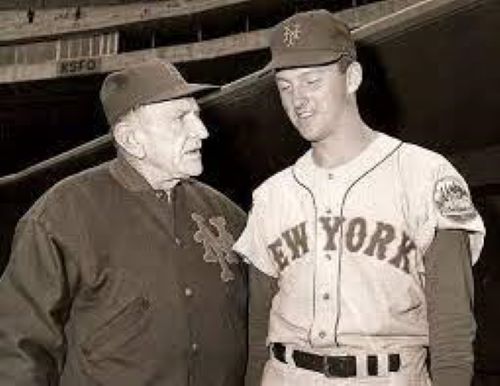 Casey Stengel and Bill Wakefield, 1964. Casey Stengel and Bill Wakefield, 1964. Fifty-seven years go fast. I was listening to the Mets’ game the other night, when a sturdy young pitcher named Tylor Megill gave up a grand-slam homer to the fourth batter in the first inning. Four up, four in. Suddenly, the Mets’ broadcaster was talking about first-inning grand-slam homers, and I heard the name of Bill Wakefield, now an email pal, but in 1964 a rookie pitcher out of Stanford, enjoying the heck out of the one year he would have in the major leagues. That year, Wakefield also gave up a grand-slam -- to Ed Bailey of the Milwaukee Braves. I told my (long-suffering) wife that a friend of mine just had his name called out on the Mets’ radio broadcast – 57 years after the deed was done. “What is it like for a ball player to be remembered for something, that long ago?” my wife asked. Well, I said, there was Ralph Branca, a good guy who gave up a homer to Bobby Thomson,also a good guy, in 1951. And I thought of other ball players who had one really bad moment that never went away. But Bailey’s grand-slam off Wakefield was hardly historic – just rare enough to pop up 57 years later. I shipped off an email to Wakefield, out in the Bay Area. How did he take being back “in the news” again? “I'll have a glass of Chardonnay,” he replied, “and/but, yes I remember it well. “I always admired the guys who answered the tough questions -- and didn't duck out early. “Sure go ahead,” Wakefield answered in two separate emails. “The only downside to telling the old stories is the rolling of the eyes and the ‘Dad, you think you've milked a modest career about long enough?’” from son Ed, 33, D1 pitcher at Portland Pilots and daughter Laura, 31, softball at Boise State!” Then Bill Wakefield, just turned 80, successful businessman, frequent e-mail correspondent, pulled out all the details that many athletes store in their competitive brains.(I’ve heard Chris Evert and Martina Navratilova discuss their epic matches, stroke by stroke.) For Bill Wakefield, it was yesterday: “ 1964 -- We're flying to Milwaukee last road trip of the year. I'm feeling pretty good for a rookie -- lot of games -- 60++++ - pretty good ERA (low 3's!!!) -- 3 – 4, not bad for Mets of that era. On the plane, Mel Harder comes to me – ‘Hey Billy - I know you've been in a lot of games but....’.” (Mel Harder, then nearly 55, had pitched 20 seasons with one team, Cleveland, and was a respected pitching coach with the Mets that year.) “Casey wants to save our starters for the Cardinals in St Louis, ‘cause they‘re in a pennant race," Wakefield recalled Harder telling him. “We're gonna start you on Thursday in Milwaukee! OK?” “Me ---What am I gonna say -- ‘Hey Mel the arm’s a little on the tired side?’ Tell Casey no? “So I say, ‘I'll be ready.’” The game was on Oct. 1, 1964. Wakefield recalls Hot Rod Kanehl, the utility player who shepherded him around the majors for one memorable season, coming up to him: “‘Hey, they're not playing Aaron today.’ So it turns out -- so what !!!! the other guys did pretty well"!!!! Wakefield added: “Hot Rod sees there are 3,000 people in the stands - at best -- and tells me - "Well kid at least a big crowd won't make you nervous.!" Ball-player gallows humor. Nervous or just arm-weary, Wakefield gave up singles to Rico Carty and Lee Maye. Felipe Alou was up next. “In that era, first inning, no outs, runners on first and second, 99% of the time the guy bunts the runners over to second and third. I'm thinking, cover third base line, field the bunt, throw to Charlie Smith at third and get the force. Get the out. “Alou hits the first pitch, one-hopper back to me - the obvious play is double play -- throw to second. I throw to third for the force -- Charlie Smith is standing, looking at second with his hands on his hips -- almost hit him between the eyes -- he drops the ball, bases drunk, I'm in trouble!!! “Rookies get in trouble and they try to throw a fast ball harder and get an out. Veterans throw softer and get a ground ball. Bailey -- first pitch -- I'm thinking two-seam fastball outside, he tries to pull it, ground ball to McMillan, and out of trouble. “It catches too much of the plate -- he goes to opposite field and hits a home run.” Wakefield fast-forwarded to the third inning. “Still a rookie. I'm still in there having trouble -- Walk Carty -- Casey comes out - Rookie question from me – ‘You taking me out because I walked Carty?’ Casey kind of has a quizzical look on his face -- and a smile and says ‘No, I'm taking you out because you've given up 7 runs!!!” Mets lost. “No excuses -- they hit the ball.” More memories: “I'm shaving after the game -- cut my chin - baseball humor -- Jack Fisher: ‘Did you try to cut your throat?’ I laughed." Then Wakefield recalled Joe Gallagher, the Mets’ TV producer, on the Mets’ charter flight that night, to St. Louis: “I said, did you lose some of your audience after the first three innings?” The Mets scared the Cardinals on that last chilly weekend, and Wakefield’s memories come pouring out: “On to St Louis -- Chase hotel -- Gaslight Square ( Hot Rod and I didn't know it -- but it would be our last visit to Gaslight Square!!) Hotel swimming pool stories - old classic hotel. Harry Caray's hang-out hotel. Casey late night in the lobby entertaining!! Westrum laughing at Casey's stories. Lou Niss smoking and watching. Whiskey-slick players file into the single lobby elevator!” My memories jog totally with Wakefield’s. The Chase-Park Plaza was also my favorite hotel on the road. The games were epic, too. “Give 'em a scare,” Wakefield recalled. The gallant original Met, Alvin Jackson, beat Bob Gibson on Friday, and the Mets won again on Saturday. Wakefield pitched in relief on Sunday and so did Gibson, to save the Cardinals’ season. The Cardinals went on to beat the Yankees in the World Series. Kanehl and Wakefield, Butch and Sundance, never played in the majors again, and remained pals until Hot Rod’s death in 2004. “I could have used a few more pitches to be a starter!! Relief -- sinker/slider, OK. Starter needs 4-5 pitches. “ He can pull up the memories of his short career: “The Milwaukee game -- I would paint a different picture if I could. There were 60 other games I would rather recall!! But that's the way it is!” Then Wakefield added: “As long as we're telling stories from 57 years ago -- who's gonna correct me??? -- make sure you also point out that I got Yogi Berra to ground into a double play in the Mayor' s Trophy Game in front of 55,000. Big deal in the era of no interleague play!!” As I told my wife, Bill Wakefield pitched a season in the major leagues, and that is something, ### My thanks to Marianne Vecsey for jogging some grand old memories. The grand-slam game, courtesy of the great website, retrosheet.org: https://www.retrosheet.org/boxesetc/1964/B10010MLN1964.htm Bill Wakefield’s career, courtesy of the other great website: https://www.baseball-reference.com/players/w/wakefbi01.shtml |
Categories
All
|




